
The Navy Department Library
GENERAL SPECIFICATIONS-APPENDIX 6
INSTRUCTIONS FOR
PAINTING AND CEMENTING
VESSELS
OF THE
UNITED STATES NAVY
__________
BUREAU OF SHIPS
NAVY DEPARTMENT
__________
EDITION OF JUNE 1943
UNITED STATES
GOVERNMENT PRINTING OFFICE
WASHINGTON : 1943
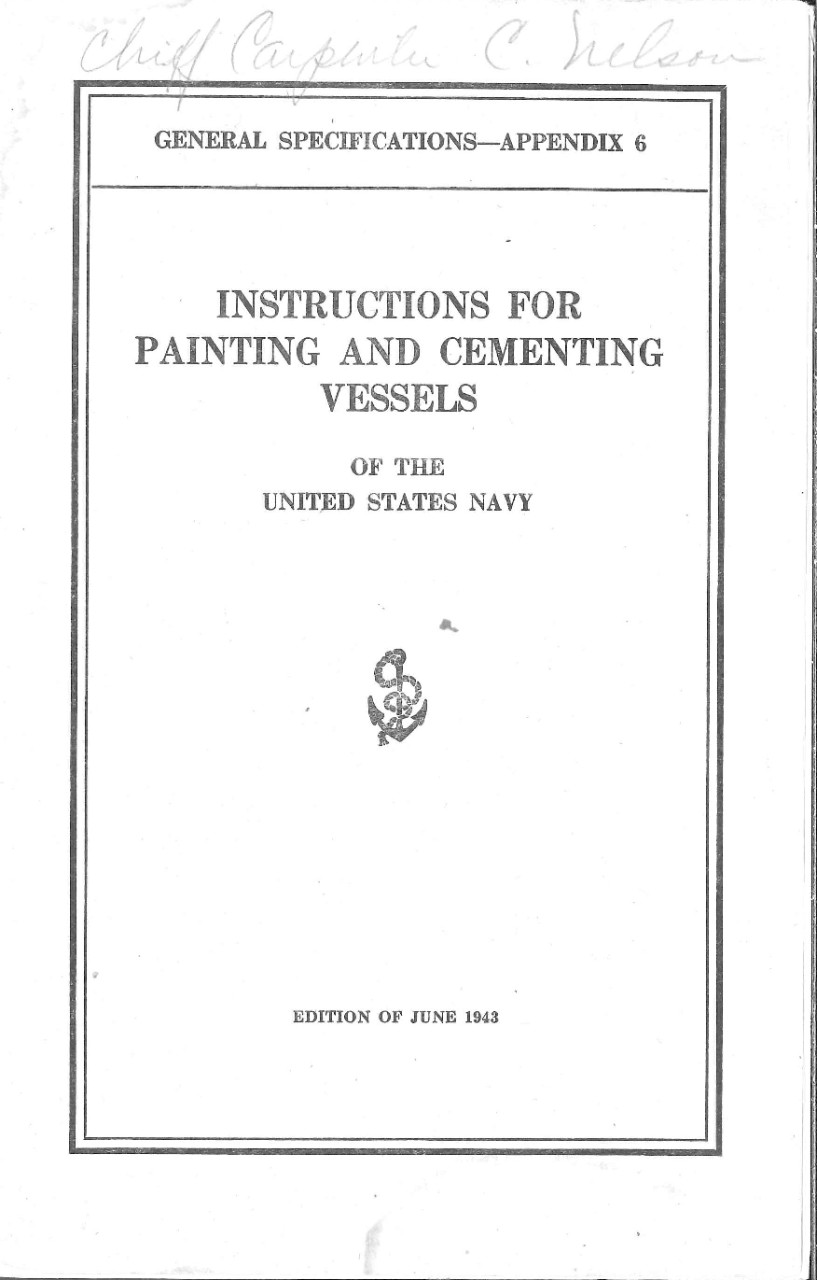
Upload PDF Version [15.1MB]
PREFFACE
This issue supersedes the November 1942 edition of appendix 6 to the General Specification for Building Vessels of the U.S. Navy and section S19-1 of September 1, 1940, to the General Specifications for Machinery. It has been prepared in order to bring the instructions into accord with current practice, to utilize recent developments, research, and tests in this field, and to issue it in the established printed form of the appendices to the General Specifications. The instructions for painting and cementing vessels will henceforth be promulgated in four publications, namely:
(1) An appendix (No.6) to the general specifications to cover the painting and cementing of new construction and conversions. (These form a part of the contract specifications.)
(2) The Ship Camouflage Instructions, U.S. Navy Ships -2. (These will contain all confidential information and amend other instructions by order where indicated.)
(3) Specifications and formulas for materials used.
(4) A manual for painting ships in service (pending as chapter 19 of the Bureau of Ships manual). (These are general instructions pertinent to painting procedure not covered by specifications.)
The material specifications will be issued individually as rapidly as they can be prepared. Pending these issues, the paints which are procured shall be in accordance with the detail manufacturing formulas.
(III)
TABLE OF CONTENTS
CHAPTER 1.-GENERAL
| Section | Page | |
| 1-A. | Requirements, general | 1 |
| 1-B. | Specifications and tests | 2 |
| 1-C. | Application instructions | 2 |
CHAPTER 2.-METAL CONSTRUCTION, PREPARATION AND PRIMING OF SURFACES
| 2-A. | Preparation | 4 |
| 2-B. | Priming treatments | 5 |
CHAPTER 3.-STEEL CONSTRUCTION-UNDERWATER BODY
| 3-A. | Hull | 9 |
| 3-B. | Propellers | 9 |
| 3-C. | Shafting | 12 |
| 3_D. | Miscellaneous appendages and special fittings | 12 |
CHAPTER 4-FINISH COATS-EXTERIOR-TOPSIDES
| 4-A. | Surface vessels | 14 |
| 4-B. | Submarines | 14 |
| 4-C. | Hospital ships | 15 |
| 4-D. | District craft | 15 |
| 4-E. | Miscellaneous items | 15 |
| 4-F. | Lettering and marking | 16 |
| 4-G. | Armor | 17 |
| 4-H. | Anchor chain | 17 |
CHAPTER 5.-INSIDE PAINTING
| 5-A. | Finish compartments | 18 |
| 5-B. | Finish of compartments-decks | 19 |
| 5-C. | Tanks, surface vessels and submarines | 20 |
| 5-D. | Inaccessible spaces | 21 |
| 5-E. | Wood finishes | 21 |
| 5-F. | Special materials | 22 |
CHAPTER 6.-MACHINERY, ELECTRICAL AND SPECIAL EQUIPMENT, PIPING, FURNITURE
| 6-A. | Machinery | 27 |
| 6-B. | Electrical installation | 30 |
| 6-C. | Piping | 35 |
| 6-D. | Gas cylinders | 36 |
| 6-E. | Miscellaneous details | 36 |
| 6-F. | Furniture | 36 |
CHAPTER 7.-WOODEN CRAFT
| 7-A. | Wooden and composite vessels of heavy construction and special design | 38 |
| 7-B. | Standard boats | 40 |
| 7-C. | Lightly built high speed craft of nonmetallic construction | 42 |
CHAPTER 8.-FORMULAS AND SPECIFICATIONS
| 8-A. | Formulas and specifications | 44 |
GENERAL SPECIFICATIONS-APPENDIX 6
__________
INSRUCTIONS FOR
PAINTING AND CEMENTING VESSELS
OF THE
UNITED STATES NAVY
__________
CHAPTER 1.-GENERAL
SECTION 1-A.
REQUIREMENTS, GENERAL.
Authority.-The instructions contained herein shall govern work done by contractors or navy yards. No departure shall be made from these requirements without specific authorization. Where the term “contractor” is used, it shall refer both to private firms and to navy yards.
Schedule.-Before the vessel is 35 percent complete a painting schedule shall be prepared by the contractors and submitted for approval by the Supervisor of Shipbuilding. This schedule shall show each section and compartment and their dissimilar parts, listing the painting and cementing required and the appropriate reference to the Specifications.
Delivery condition.-Upon delivery the painting and cementing work on the vessel shall be in an acceptable serviceable condition. The contractor shall be required to accomplish such repairs, replacement or repainting as may be necessary to produce this result.
At the discretion of the Supervisor of Shipbuilding, the fourth coat of exterior finishing paint of vessels under construction may be omitted provided that in authorizing this omission, painting will be required which will afford satisfactory protection for the preservation of material. This omission will be authorized only in those cases in which such omission will result in earlier delivery of the vessel concerned.
(1)
2
SECTION 1-B.
SPECIFICATIONS AND TESTS.
Specifications.-All materials used in painting and cementing shall conform to the requirements in the applicable Federal or Navy Department specifications. These materials and their usage shall be in accordance with general instructions herein. The contractor is encouraged to use the latest specifications available, regardless of the date of contract. Changes under the contract will be considered to cover changes in cost and weight whenever these may be involved.
Tests.-At private yards, material shall be subject to test at any time by the Supervisor of Shipbuilding. All material shall be kept available for inspection. Samples for test shall be sent to the Test Laboratory, Navy Yard, Philadelphia, Pa., or the Navy Yard, Mare Island, Calif., or the Navy Yard, Norfolk, Va. A test at a private laboratory may be made at the request and at the expense of the contractor, if approved by and reported to the Supervisor of Shipbuilding. Materials failing tests shall be rejected for use and work already done with these materials shall be removed.
SECTION 1-C.
APPLICATION INSTRUCTIONS.
Paints.-Paints recently formulated are far superior in durability to those made according to older formulas. They are made to give good hiding and durability in thin films and should be so applied in order to minimize the fire hazard, prevent cracking and peeling, and to conserve weight. Primers have been found to be most effective at a thickness of from 0.0007 to 0.0010 inch and should be so applied.
For general interior painting a two-coat system as follows is considered adequate:
One complete coat of primer formula 84 shall be applied. This may be the original after pickling paint formula 84, touched up; or a complete coat over the remnants of the after pickling coat or the bare steel.
The finish coat.
The thickness of this system shall not exceed 0.002 inch.
Exteriors shall be painted with a four-coat system for better weather resistance:
(1) The after pickling primer formula 84.
(2) A second priming coat formula 84 overall.
(3) An under coat overall.
(4) A top coat.
3
Galvanized exteriors will require only three coats, since no after pickling primer will be applied.
Except for touching up and for marking, all paint shall be spray coated whenever possible.
Cements and gunning compounds.-Portland cements shall not be used unless specifically directed and shall never be used for the sole purpose of filling voids.
Pastes or gunning compounds shall be used only when oil and water tightness cannot be otherwise attained. To conserve weight, they shall be used sparingly.
CHAPTER 2.-METAL CONSTRUCTION, PREPARATION AND PRIMING OF SURFACES
SECTION 2-A.
PREPARATION.
General.-A prerequisite to acceptable paint performance is to put the surface in a satisfactory condition for painting; therefore, thorough cleaning is essential.
The cleaning procedure must include the complete removal of rust and mill scale, solvent removal of any oil and grease, and thorough drying.
Painting at temperatures below 32F. shall not be done, except in urgent cases where authority has been obtained.
Under conditions of high humidity, the temperature of the structure should be increased, or the air in compartments cooled and dried to prevent condensation and to maintain a dry surface.
Steel which is not to be galvanized.-Rust and mill scale shall be effectively removed by acid-pickling, flame-descaling or wire brushing as described in section C-7 of the General Specifications, or by an approved blasting process.
Grease shall be removed with noninflammable solvent and surfaces wiped dry with rags. If specifically required by the Supervisor of Shipbuilding, pitted surfaces otherwise acceptable may be smoothed out with cement formula 62.
Aluminum alloy.-Wherever possible, cleaning of aluminum alloy shall be done prior to assembly of parts. Cleaning before assembly shall be accomplished by immersing the part in, or swabbing with, a cleaner consisting of a dilute water solution of phosphoric acid and organic solvents. The solution temperature shall be about 70 F. The solution shall remain in contact with the metal for not over 5 minutes. Residual solution shall be removed, with clear cold water, followed by hot water, until no trace of acid is detected.
When necessary to clean after assembly, the assembled parts shall be cleaned with mineral spirits, benzene, carbon tetrachloride, trichloroethylene or a mixture thereof, in lieu of the solution used for unassembled parts, since acid may be retained between faying surfaces and cause corrosion or breakdown of pain subsequently applied.
(4)
5
Light sandblasting, following the use of the above solvents, is permissible for producing a good adhering surface for paint, provided care is exercised to control the force and direction of the blast so as not to distort or damage the material.
Welded parts shall have all traces of flux removed before painting. This may be accomplished by brushing the welds while immersed in boiling water. For inaccessible welds, the part may be cleaned by immersing in a cold solution of 10 percent sulphuric acid for 30 minutes, or a 5 percent solution of sulphuric acid held at 150 F.for 10 minutes. The acid should contact both the inside and outside surfaces. The above cited treatments shall be followed by a thorough rinse in clean warm water until no trace of acid is detected. Residual flux may be detected by leaching the surface with distilled water, and adding a few drops of 5 percent silver nitrate solution to the leach. A white precipitate indicates the presence of flux.
Galvanized surfaces to be painted.-All zinc-coated surfaces which are to be painted shall be treated with an approved cleaner consisting of phosphates, phosphoric acid, and suitable solvents and wetting agents to enable the surface to be coated with a thin phosphate coating. Where the galvanized material has not been procured in the treated condition, the solution shall be painted on the galvanized surface with a large brush and allowed to act with cold water, then with hot water, and, when dry, formula 84 primer shall be applied. Care should be taken to minimize handling the surface following the coating and prior to the application of the primer.
Miscellaneous metals.-Corrosion-resting steel, nickel-copper alloy, copper and brass that are to be painted shall be cleaned with noninflammable solvent. Welds shall be brushed with corrosion-resisting metal wire brushes.
SECTION 2-B.
PRIMING TREATMENTS.
Steel not to be galvanized.-Pickled or furnace material, after scale removal and when clean and dry, shall be spray painted with one coat of zinc-chromate primer, formula 84. Tinted formulas such as formula 84G and formula 84R may be used to distinguish between various types of steels.
During construction, areas which become bare or where rust shows shall be touched up after wire-brushing with one coat of primer, formula 84.
Before launching, the exterior only shall receive one complete second coat of primer, formula 84. Above the waterline this
6
second coat of primer shall be tinted to a dark color such as formula 84D. Tinted primer, formula 84D, shall be used also below the waterline on submarines to insure the maintenance of a dark surface should there be any topcoat peeling.
Decks and platforms to be covered with cement, or composition deck coverings (mastic or the like) shall not be given a priming coat of paint, unless the decks during the construction period are to be left uncovered sufficiently long for corrosion to be of a serious nature, in which case they shall be painted for protective purposes as directed by the Supervisor of Shipbuilding. Before coating with cement or composition, the paint shall be removed down to bare metal.
After completion of interior constructions, the after-pickling coating shall be touched up. All surfaces not already painted, shall receive one coat of zinc-chromate primer, formula 84.
Zinc-coated metal.-Exterior galvanized structure and the interior of the superstructure of submarines shall be primed and painted. Interior galvanized structure and equipment except submarine superstructure are normally unpainted, unless painting is considered necessary by the Supervisor of Shipbuilding.
Galvanizing destroyed by welding or cutting, galvanized wire mesh, or expanded metal shall be touched up with one coat of primer, formula 84, and shall be finish-painted the color of surrounding structure, except in gasoline or fresh water tanks, where the welded area shall be recoated with zinc, metal-sprayed.
All galvanized areas to be painted shall receive one complete coat of zinc-chromate primer, formula 84.
Aluminum alloy.-Frames and stanchions of aluminum pipe berths shall not be unpainted.
Crew’s clothes lockers, bins, shelves, etc., when constructed of aluminum shall be left unpainted.
Aluminum alloy bins, uprights, battens, fittings, etc., in magazines shall be left unpainted.
All aluminum surfaces which are to be painted shall be given a priming coat of zinc-chromate primer, formula 84. This priming coat shall be applied as soon as possible after the metal has been cleaned, rinsed, and dried. If necessary, the priming coat shall be touched up before application of subsequent coats.
Where aluminum alloy surfaces are to be made bright work, the priming coat will not be required. Such bright surfaces shall, however, be waxed.
Where aluminum materials are to be given finishing coats, or where appearance is unimportant, the faying surfaces shall be coated with zinc-chromate primer, formula 84. Where the material is to be left bright, as for crew’s lockers, the faying surfaces
7
Shall be coated with varnish, phenolic type, formula 80. Each of the faying surfaces shall be painted and allowed to dry before being brought together, and just before being brought together each shall be given an additional coat of the required paint or varnish.
For no watertight joints, aluminum shall be protected from contact with dissimilar metals, including galvanized steel, and from contact with wood or other absorbent materials which tend to become water-soaked, by an approved, nonabsorbent gasket material or by sealing compound in accordance with Navy Department Specification 52C12. Canton flannel which has been soaked thoroughly for at least 12 hours in zinc-chromate primer, formula 84, may be used for parts subsequently to be painted. For parts to be left bright, the impregnating medium shall be varnish, phenolic type, formula 80. Gaskets of this type shall be installed while wet.
Where gaskets of sealing compounds are used between faying surfaces the second coat (wet) of primer may be omitted.
Wood in contact with aluminum shall be painted before assembly with one coat of varnish, phenolic type, formula 80.
Sealing compounds, in accordance with Navy Department Specification 52C12, shall be used for such nonwatertight work as joints of ventilation ducts.
Watertight joints between aluminum parts, or between aluminum and galvanized steel, shall be made tight by calking on both sides and without the use of gaskets or packing, wherever possible. Where such calking is not possible, or where aluminum is in contact with material other than aluminum or galvanized steel, canton flannel impregnated and installed as described above, approved gasket materials, or calking compounds in accordance with Navy Department Specification 52C12 shall be used.
Crevices, such as those occurring between aluminum bulkhead plating and airport and window frames, shall be sealed with sealing compounds in accordance with Navy Department Specification 52C12.
Asbestos paper, or similar absorbent material, shall not be used in contact with aluminum.
All threaded parts of aluminum alloys, whether aluminum alloy to aluminum alloy or aluminum alloy to a dissimilar metal, shall be coated before assembly with an antiseize mixture of 50 percent zinc dust and 50 percent petrolatum.
Aluminum gratings shall be primed before assembly.
Aluminum airplane tracks shall have all surfaces except wearing surfaces treated and painted in accordance with the requirements for painting other aluminum material.
8
Bolts which are to be used in clearance holes in aluminum, with the exception of the threaded portion, shall be coated with sealing compound in accordance with Navy Department Specification 52C12, before being inserted in the holes.
The fastenings of aluminum alloys shall be in accordance with the General Specifications for Building Vessels of the United States Navy, edition 1936, Section C-6, except that zinc-chromate primer, formula 84, shall be used in lieu of zinc-chromate iron-oxide primer.
Label plates, regardless of material, which are installed on aluminum structure of fittings, shall be imbedded in a plastic sealing compound in accordance with Navy Department Specifications 52C12.
Surfaces of aluminum material which are not readily accessible for inspection and maintenance after assembly, such as the unexposed surfaces of insulation sheathing, quick-operating door guards, etc., shall be given two coats of zinc-chromate primer, formula 84.
Other metals.-Corrosion-resisting steel and copper-nickel alloy will normally be left bright, except when painting is considered necessary for preservation or appearance. Inaccessible areas and metal to be painted shall receive one coat primer, formula 84.
Copper and brass gage cases, electrical fixtures, hatch and door frames, covers, ladder side stringers, pipe outside machinery spaces and other parts not requiring frequent handling shall receive one coat of primer, formula 84, and be finished painted.
Metal plaques, trophies, data plates, and nonferrous metal requiring frequent handling shall not be painted, but for camouflage purposes visible brightwork topsides must be kept at an absolute minimum.
CHAPTER 3. STEEL CONSTRUCTION-UNDERWATER BODY
SECTION 3-A.
HULL.
The underwater body of steel vessels shall be coated in accordance with procedures indicated in table I.
It is undesirable to apply cold plastic paint over hot plastic as the solvent in the cold plastic may dissolve the paraffin and soften the resin in the hot plastic with unsatisfactory results. It is important for satisfactory performance of the plastic painting systems to afford adequate time for thorough drying of the primer and anticorrosive paint. In average fair weather conditions, practically all of the volatiles have been released by the end of four hours. Anticorrosive paint, formula 14D, may be produced by adding one pound of lampblack to 10 gallons of paint, formula 14.
Boot-topping painting.-The boot-topping area on oilers, cargo vessels, and similar craft with a wide variation in service drafts shall extend from the light-load waterline to 6 inches above the full-load waterline.
The lower edge of the boot-topping area on other surface vessels shall be the designer’s waterline and the upper edge shall be 6 inches above the full-load waterline.
On submarines, the boot-topping shall extend from the water line at maximum beam to the intersection of the superstructure and the outer hull.
SECTION 3-B.
PROPELLERS.
Composition propellers shall not be painted, but shall be cleaned, polished bright, and coated with rust-preventive compound, Grade I, Navy Department Specification 52C18.
Pits and rough portions of cast iron propellers should be thoroughly cleaned and filled with iron cement before being painted. The same kinds of paint and number of coats shall be applied as are used on the hull bottom.
9
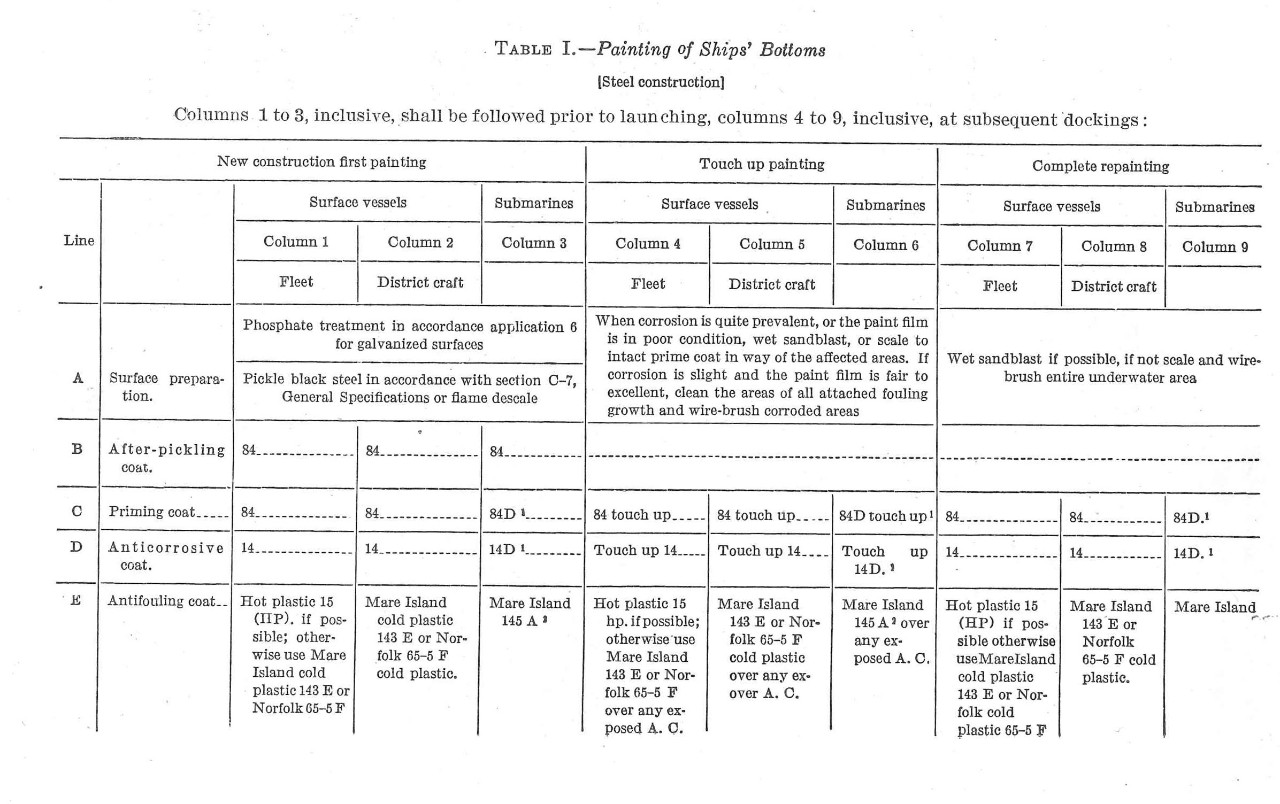

12
SECTION 3-C.
SHAFTING.
Outboard protection.-To avoid shaft fracture due to corrosion fatigue, it is necessary that pitting be prevented. In order to insure this, all outboard shafting shall be carefully sand- or grit-blasted prior to painting.
Immediately after blasting, one coat of zinc-chromate primer, formula 84 or formula 84D, shall be applied whether the shaft is blasted after installation or in the shop.
Prior to launching or undocking, apply an additional coat of zinc-chromate primer. Allow eight hours to dry and apply one coat of anticorrosive paint, formula 14 or formula 14D. Allow four hours to dry, then apply one coat of hot or cold plastic antifouling paint.
All parts of shafting which are inaccessible for painting and not protected by bearing sleeves of metallic casings shall be covered by rubber or by other specially approved materials.
The Bureau may specify special coatings for the accessible portions of steel shafts of wooden craft to minimize corrosion.
Inboard protection.-Inboard sections of propulsion shafting shall receive two coats of zinc-chromate primer, formula 84, and one coat of light gray machinery enamel, formula 30-L.
SECTION 3-D.
MISCELANEOUS APPENDAGES AND SPECIAL FITTINGS.
Keels.-Bilge and docking keels shall have the interiors coated with a mixture of equal parts of pitch and pine tar, or rust-preventive compound, Grade I, Navy Department Specification 52C18.
Rudders shall be coated internally with rust-preventive compound, Grade I, Navy Department Specification 52C18.
Protectors shall be imbedded in zinc oxide paste, all edges calked, and all except zincs painted.
Underwater sound devices.-After the final setting up on plugs and bolts of all underwater sound equipment all recesses shall be filled with potting compound.
The corrosion-resisting surfaces (outside and inside) of sound transparent windows of all types of echo-ranging domes, the corrosion-resisting diaphragms of all flat echo-ranging protectors (except those housed in water-tight domes filled with rust-inhibitive fluids such as sodium chromate solution), the corrosion-resisting hemispherical covers of spherical type projectors, and the bearing surfaces, shafts, slides, and guide rods, shall be coated with a thin film of suitable water-resisting grade of rust-preventive compound, Grade I, Navy Department Specification 52C18.
13
Rubber hemispherical sections and rubber-covered flat diaphragms of projectors shall be coated with a solution of chlorinated rubber in xylol, plasticized with castor oil, formula 94.
All remaining areas should be coated in the same manner as the ship’s bottom.
CHAPTER 4.-FINISH COATS-EXTERIOR-TOPSIDES
SECTION 4-A.
SURFACE VESSELS.
Before trials, the vertical surfaces above the upper limit of the boot-topping paint shall be painted haze gray, formula 5H, and, in general, horizontal surfaces shall be painted deck blue, formula 20B.
Camouflage.-Certain camouflage measures have been established, and are described in the confidential publication, “Ship Camouflage Instructions” (Short Title: Ships -2). The Supervisor of Shipbuilding shall ascertain from the prospective commanding officer which camouflage measure is to be applied, in time to permit its application prior to delivery, if possible.
Flight decks.-Painting of aircraft carrier flight decks shall follow specific instructions from the Bureau of Ships.
SECTION 4-B.
SUBMARINES.
Submarines shall have the exterior metal surfaces above the water line at maximum beam painted with one coat of MI-146 over one coat of the dark zinc chromate primer, formula 84D, and one coat of dark anticorrosive paint, formula 14D. Wood slat decking shall be painted with two coats of copper bottom paint No. 16, colored black by the addition of one-half pound of dry lampblack per gallon of paint.
Ungalvanized areas within the superstructure and fairwaters and the interior of free-flooding spaces, shall be painted with one coat of black plastic composition, formula 90, over one coat of dark zinc chromate primer, formula 84D, and one coat of anticorrosive paint, formula 14D.
Galvanized areas inside the superstructure and fairwaters and the interior of free-flooding spaces, shall be painted with one coat of dull black paint, formula 13, over one coat of dark zinc chromate primer, formula 84D.
15
SECTION 4-C.
HOSPITAL SHIPS.
Unless otherwise directed, hospital ships shall receive 2 coats of outside white, formula 6, above limit of the boot-topping paint. A green 5-foot band (formula 12) shall be painted continuously around the ship with the upper edge parallel to and 5 feet below the sheer line. Crosses as large as practicable shall be painted with red, formula 40, on each side of the hull amidships, on a horizontal section visible from above, and on the stacks so as to show ahead, astern, and on each side. The width of the cross stripes will be as nearly as possible one-third the length.
SECTION 4-D.
DISTRICT CRAFT.
Yard and district craft shall be painted as follows:
Self-propelled vessels, torpedo testing barges, water barges.
Vertical surfaces-ocean gray, formula 5-O
Horizontal surfaces-deck blue, formula 20-B
Non-self propelled vessels.
Hull above upper limit of antifouling including decks-dull black formula 13
Upper works-ocean gray formula 5-O.
SECTION 4-E.
MISCELLANEOUS ITEMS.
Decks.-Metal weather decks, such as the forecastle, gun platforms, and passageways of destroyers, which require a nonskid surface though wet, shall be treated by either of the following methods:
Method I.-Light weight deck covering, Navy Department Specification 52D9, shall be used.
Method II.-
(a) Apply one coat of varnish, formula 80, over zinc-chromate primer. Sprinkle fine sand over the varnish immediately and dust off when varnish is dry.
(b) Apply two coats of deck paint, formula 20-B.
Waterways shall be painted to agree with camouflage measures for the adjacent deck.
Stacks.-The top of each stack shall have a black band, formula 13, painted to a depth of one-sixth the fore and aft pipe dimension but not to exceed 24 inches, unless camouflage instructions require otherwise.
Foundations.-Inaccessible areas of crane and machinery foundations shall be coated with pigmented rust preventive compound, Navy Department Specification 14C6, Type II.
16
Life preservers.-Metallic life preservers shall be unpainted; canvas covers on cork preservers shall be treated with white canvas preservative (Navy Department Specification 52C26) and marked with ship’s name or designating number with black formula 38, unless otherwise directed by camouflage instructions.
Canvas, when required by camouflage instructions, shall be dyed with a preservative (Navy Department Specification 52C26) tinted to the color of the deck blue paint, formula 20-B.
Side lights.-The inside surfaces of side light boxes shall be painted, red formula 40, for the port side lights and green, formula 39, for the starboard side lights.
Rigging.-Rigging in way of insulators shall be painted with zinc-chromate paint, formula 84D. Insulators shall be kept entirely free of paint.
Fittings.-Other exterior fittings of wood or metal shall be painted to match the surrounding structure in their stowed position.
The portions of wood masts that are within deckhouses or other enclosures shall be finished to harmonize with the surroundings. Stains shall not be used, and where filler is needed, it shall be transparent, Navy Department Specifications 52F1.
Wood side ladders (accommodation ladders) and platforms shall be finished in natural wood and varnished, formula 80. In time of war they shall be painted to match the surrounding structure when stowed.
Frequently handled brightwork metal objects shall be normally be left unpainted.
For camouflage purposes, all visible brightwork shall be painted when possible, or glare masked with a dark rust preventive compound.
SECTION 4-F.
LETTERING AND MARKING.
Ship’s names (plan Bu.Ships No. 51497) shall be painted with outside white No. 6 on black vessels, with black formula 13 on light gray vessels and with gold leaf on white vessels. When a camouflage measure is applied, names will be painted out.
Draft marks shall be painted with white formula 6 over the underwater painting or black hull, black formula 13 above boot-topping over white or gray.
Distinguishing numerals shall be painted white formula 6 on the bow in general accordance with plan Bu. Ships No. 469497. No letters shall precede the number.
17
Yard craft shall be marked with letters and number, preceded by “U.S. Navy”.
SECTION 4-G.
ARMOR.
Faying surfaces of armor including butts and seams of side armor normally exposed to salt water shall be given one coat of zinc-chromate primer formula 84. The outboard side of the shell plating in the way of armor shall be given one touch-up coat and one additional coat of zinc-chromate primer formula 84, and the spaces between shell and armor filled with such armor backing compound as is required by the Detail Specifications.
SECTION 4-H.
ANCHOR CHAIN.
Anchor chain shall be painted black, formula 45.
CHAPTER 5.-INSIDE PAINTING
SECTION 5-A
FINISH OF COMPARTMENTS
The kind of paint for the finish of interior compartments shall be in accordance with the subjoining table.
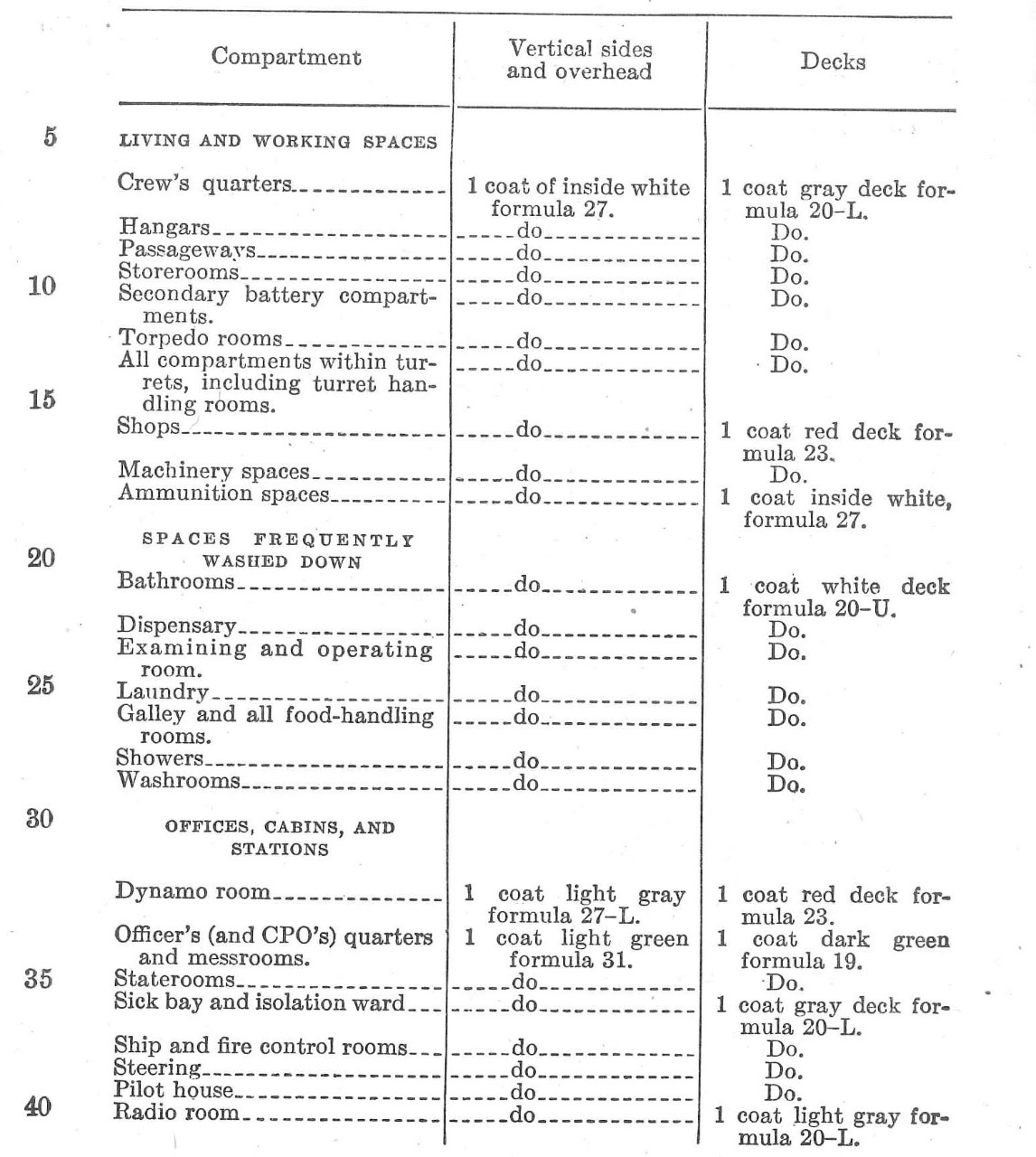
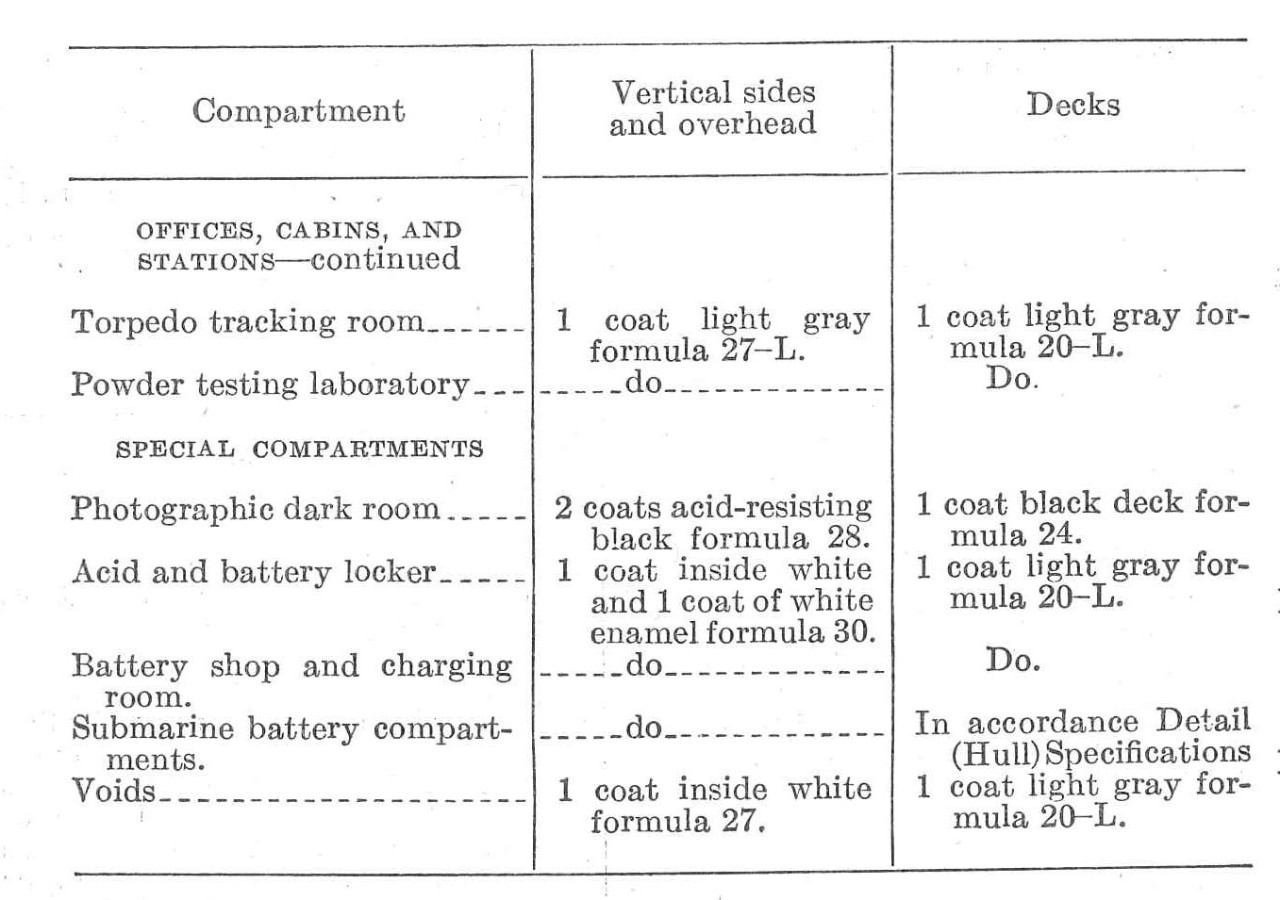
Fiber glass insulation.-Fiber glass board insulation shall be painted with one coat of fire-retardant paint to match the surrounding structure.
SECTION 5-B.
FINISH OF COMPARTMENTS-DECKS.
Wash strake.-In general, bounding angles attaching decks to bulkheads, shell plating, and other vertical members, shall be painted the same color as the bulkhead or vertical member to which attached. Where there is no bounding angle the color of the bulkhead shall be carried out on the deck to the edge of the fixed deck covering. If the deck is bare and painted, the bulkhead color shall be carried to the toe of the welding bead adjacent to bulkhead.
Multiple course decks.-Before riveting, the upper surface of the lower course and under surface of upper course, and both surfaces of intermediate courses of protective deck plating or other structure plated in two or more courses, shall be thoroughly coated with rust preventive compound, Navy Department Specification 14C6, Grade II.
Surfaces under gratings.-Metal surfaces on which gratings, or solid wood shutters are to be laid, except corrosion-resisting steel, copper-nickel alloy, aluminum, and surfaces specified as gray, shall be thoroughly coated with zinc-chromate primer formula 84.
20
SECTION 5-C.
TANKS, SURFACE VESSELS AND SUBMARINES.
General requirements.-The entire inner surface of tanks shall be coated as specified in the following table, except that surfaces which are galvanized need not be painted:
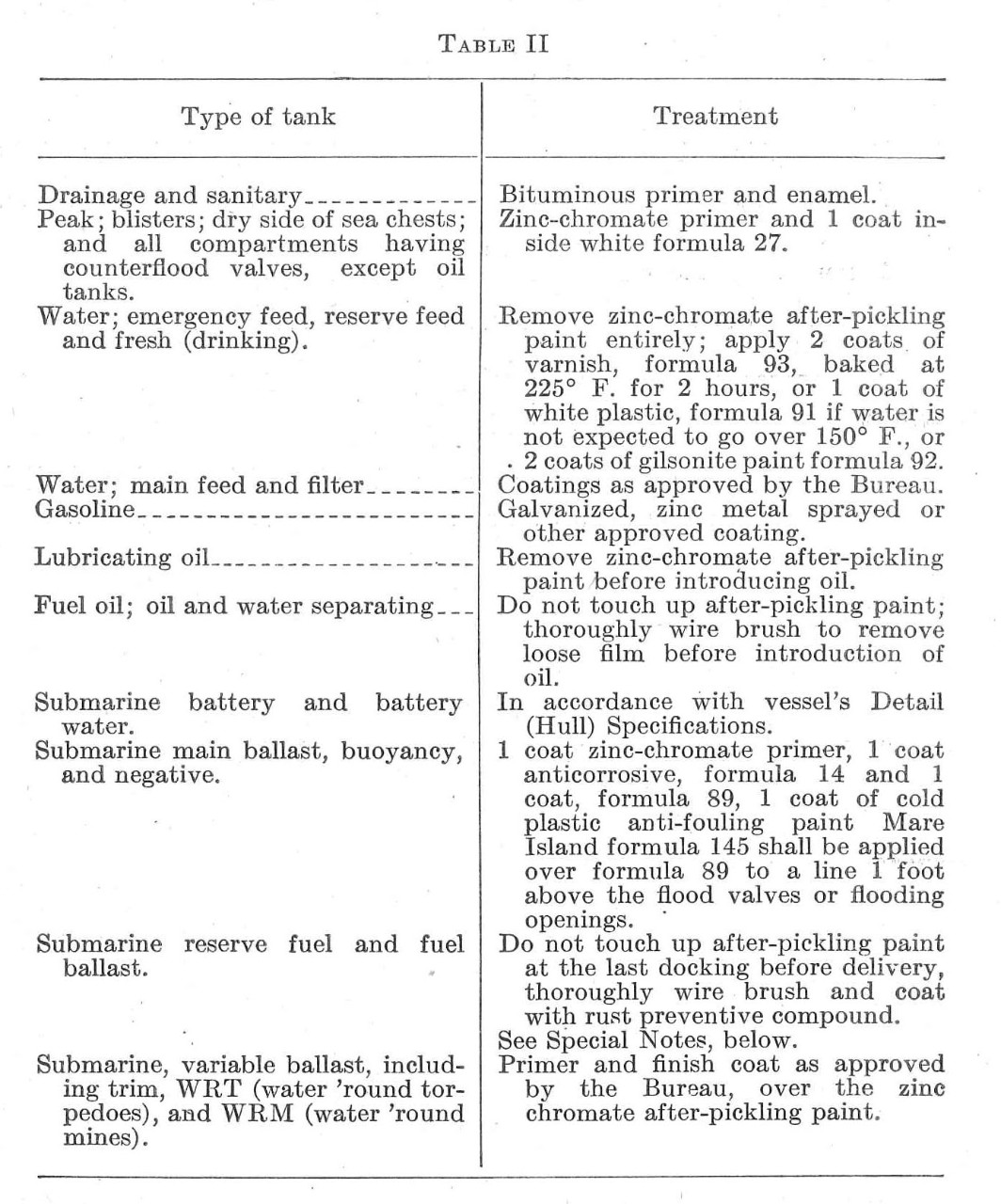
Special notes.-Plate edges, rivet heads, and points that are ungalvanized shall be thoroughly coated as specified above for the respective tank.
Bilges shall receive one coat of inside white paint formula 27 over the zinc chromate primer.
21
The interior of compartments not fuel-oil tanks proper, but made oil tight for the purpose of carrying oil at some future date, shall not be painted until after having passed a satisfactory test. However, this requirement is not to be construed as prohibiting the coating of the steel immediately after pickling with zinc-chromate primer formula 84. If, after test, the paint is in good condition, it shall be touched up as necessary during the construction period and this may be considered as the finish coat of paint. Otherwise it shall be removed and a complete coat of zinc-chromate primer applied.
In lubricating oil tanks if there is a considerable lapse of time between wire brushing of the paint film and the admission of oil, the surfaces shall be given a coat of rust preventive compound, Navy Department Specification 52C18, Grade II. The final cleaning of the tanks shall be deferred until all work within the tanks has been completed and necessity for further entering the tank is unlikely.
In submarine reserve fuel or fuel ballast tanks, if fuel oil is to be placed in them within 6 months, these tanks may be coated with fuel oil and recoated with fuel oil at intervals as necessary to avoid appreciable rusting. The coating of fuel oil herein described may be applied by putting fuel oil into the tanks and transferring it by compensation.
SECTION 5-D.
INACCESSIBLE SPACES.
The following inaccessible and ungalvanized spaces which cannot conveniently be reached for repainting, shall be cleaned, and coated with bituminous primer and enamel, Navy Department Specification 52P17 (to a thickness of 1/16 to 1/8 inch) or coated with pigmented rust preventive compound, Navy Department, Specification 14C6, Type A:
Bilge wells.
Peak tanks.
Machinery foundations.
Areas under built-in furniture shall receive 1 complete coat of zinc-chromate primer, formula 84, in addition to the after-pickling coat.
Areas beneath cement and tiling.
SECTION 5-E.
WOOD FINISHES.
Unpainted or unvarnished wood (hardwood gratings, etc.) shall be treated with boiled linseed oil for preservation.
22
Wood to be varnished shall be filled and stained to the shade desired and three coats of formula 80 varnish applied. Undercoats shall be sanded and finish coat polished to give an acceptable finish. Wood to be painted shall be given two coats of paint to match surrounds.
SECTION 5-F.
SPECIAL MATERIALS.
Bituminous composition.-
Preparation of surface.-The preparation of a surface for bituminous compositions shall not be started until it is certain that no other work will be under way in or over the bilge or compartment to be coated, and that no water, grease, or oil will be drained into the compartment. In applying bituminous compositions, it is absolutely essential that the surfaces to be covered are thoroughly dry and cleaned down to the bare metal. The utmost care shall be exercised to insure that the surfaces are entirely cleaned of all rust, grease, scale, or paint. The metal shall be cleaned bright by sandpapering, sandblasting, or other approved means. Where the surface is pitted, it may be brushed hard with a fine steel wire brush, such as is used preparatory to galvanizing or nickel plating, or by other approved means, to insure that the bottoms of pits are made as clean and bright as the smooth surface of the plate. All dust shall be removed just prior to applying the bituminous primer (solution).
Temperature.-In cold weather it may be necessary, in order to avoid having damp or minutely frosted surfaces, to blow heated air to insure satisfactory contact of the bituminous primer (solution).
Heating.-Bituminous enamel shall be heated in pots provided with thermometers, and temperatures shall be regulated within limits specified by the manufacturers of the enamel.
Application.-The bituminous primer (solution) shall be applied as soon as practicable after the structure has been cleaned and made ready. It shall be well spread with brush, and care shall be taken to insure that no spots are left uncovered. After the primer coat has dried, or at least becomes tacky, it shall be followed by a coat of bituminous enamel, applied hot. In any case, bituminous enamel shall be applied within 24 hours after the primer is applied. Long drying periods result in lack of adhesion of the enamel.
23
The enamel shall be applied to the lower surfaces first, as it has been found that in coating the upper surfaces first, drippings and streamers therefrom cause difficulty in the proper coating of the lower surfaces. It shall be applied with a brush to a minimum thickness of 1/16 inch. For flat horizontal surfaces the enamel shall be spread rapidly with a brush or some equally efficient means to a minimum thickness of 1/8 inch, except in continuously wet bilges and sumps where the thickness shall be ¼ inch.
The enamel shall be applied along the lower edge of the bulkhead bounding angles, boiler and machinery foundations, and other metal work projecting through the enamel, in order completely to coat the angles.
As the primer (solution) and enamel are both black, it is difficult to see where the enamel has been applied. Special care is necessary, therefore, to insure that the entire surface is coated with enamel.
The applied film of bituminous primer (solution) shall be perfectly clean and free from all grease, dirt, oil, moisture, etc., before applying the enamel.
Bituminous solution is intended only as a bond between the enamel and the metal surface. It is not a protective coating and therefore shall not be used as such.
Plastic compositions for tanks.-The material is broken up by sledges into pieces whose largest dimension should not be over 6 inches. The broken material is melted in steam-heated or gas-fired reducing kettles (standard hot plastic reducing kettles) and raised to a temperature of 400 F. The reducing kettle should be as close as possible to the place of application to avoid heat losses in transferring the material. When it is inconvenient or impossible to place the reducing kettle in the bottom of the drydock near the work, a 10-gallon “holding kettle” is used to maintain a supply of material at 400 F. within a few feet of the tank openings.
The material at 400 F. is drawn off as needed into insulated gallon paint pots and is immediately handed into the tank for application. Ordinarily between ½ and ¾ of a gallon of melted material is placed in each pot. The amount should be regulated so that all the material in the pot can be brushed out before the temperature drops below 300 F. Under average conditions the material will maintain sufficient heat for 20 minutes if an insulated pot is used. A standard one gallon paint is satisfactory. This pot is slipped into a detachable asbestos lagged shell which clamps onto the bail supports of the standard pot.
24
A standard 2 ½-inch brush has been found to be the most efficient for a brush application. The brush should not be dipped over 2 inches into the melted material. If too much paint is taken on the brush it will be difficult to brush it out to a thin, even layer before it hardens. All work should be carefully examined for pinholes and holidays as the work progresses. A coating between 1/32 and 1/50 inch is considered ideal and is easily attained if the material is applied correctly and at a temperature above 300 F. A coating this thickness weighs between 0.135 and 0.25 pounds per square foot.
Material can also be applied by spraying with the standard equipment used for the application of hot plastic antifouling paint. All bulkheads and large flat areas are easily coated with the hot spray. The smaller areas such as stiffeners, I-beams, etc., cannot be sprayed very well with this equipment and are best touched up by brush after the larger areas have been coated. Any pinholes in the sprayed areas are also touched up with a brush at this time. The spray job gives a slightly heavier film than a good brush application but the increase in weight is not considered excessive in view of the saving of time and labor.
Portland cement.-
Applications.-No cement shall be applied until compartments are completed and tested satisfactorily for tightness. Wherever cement is proposed for use on iron or steel, the extent, location, and details of the installation shall be referred to the Bureau for approval.
Uses.-Cement shall be used only for the following purposes:
Continuous or with tiling in areas around water drains. It shall be applied over bituminous enamel and slope toward the drain. The total thickness shall not exceed 1 ¾ inches.
On a specific approval and to a minimum thickness for filling pockets and crevices.
Where ceramic tiling is provided as a deck covering, the deck plating shall be stiffened where necessary, it being considered that this will be necessary for plating under 10.2 pounds on 4-foot beam spacing. The method and order of application shall be as follows:
Bituminous coat, primer and enamel; 3/16 inch thick.
Concrete, 1 part Portland cement, 2 parts Haydite or equivalent; ¾ inch thick.
Float coat for title, 1 part Portland cement, 1 part sand; ½ inch thick.
Title, ¼ inch thick.
Total thickness shall not exceed 1 ¾ inches except as required for drainage.
25
In applying the base for the tile, the deck plating shall first be thoroughly cleaned, the bituminous primer shall then be applied cold, followed by the enamel, applied hot, then another coat of primer with dry Portland cement scattered over the surface while wet. The concrete shall then be applied, followed with the float coat and tile.
All metal blocks and stools for fastenings in way of the tiling shall be welded to the deck or secured by at least two fastenings before the cement is laid.
Gutters and floor drains shall be fitted as required. Tiling shall in all cases slope toward the drain and in addition shall slope locally away from the bulkheads and fittings to prevent water standing against the metal. Fillet tile shall be used at bulkheads and coamings, except where the bulkhead stiffening renders this impracticable.
Quality.-Cement used on vessels shall be of a light weight grade preferably one developing high early strength. Cement shall be mixed with siliceous sand which shall consist of a well-graded mixture of coarse grains predominating. Not more than 30 percent shall pass a No. 50 sieve. It shall be free from clay, loam, mud, salt, alkali, organic matter, or other impurities, and particles shall not be coated. It shall be screened to remove all particles not passing a ¼-inch mesh screen, unless, in the opinion of the officer-in-charge, the proportion of particles above ¼ inch is so small that the sand will perform its functions in the concrete without screening. Sand for concrete shall contain not more than 5 percent of silt when measured by volume by shaking a sample of the material with water and allowing it to settle.
Crusher screenings passing a ¼-inch mesh screen may be combined with and measured as sand, but not more than 1/3 of the same in any one batch shall be of this material, unless it can be shown that the sizes of the particles are practically in the same proportion as in the most suitable grades of natural sand.
Mixing.-In mixing Portland cement (except for setting tiling and except where used as a deck covering) 1 part of cement and 2 parts of sand shall be used for the filling coat. This shall be mixed in small quantities to prevent setting prior to application, and in general, shall be mixed with the least amount of water that will permit a proper consistency for working.
Curing.-The necessary curing after the cement has set shall be done by keeping the work moist from about 2 to 10 days depending upon the type of Portland cement used, early strength requiring less time.
26
Testing.-All cement shall be carefully tested to ascertain whether it has properly adhered to the metal and, where not found to adhere, the contractors will be required to remove the old cement and apply new cement until such adherence is obtained.
Rust preventive compound.-Rust preventive compound shall be applied so that the thickness does not exceed 1/16 inch. Where the thickness after application exceeds 1/16 inch, the excess thickness shall be scraped off.
CHAPTER 6.-MACHINERY, ELECTRICAL AND SPECIAL EQUIPMENT, PIPING, FURNITURE
SECTION 6-A.
MACHINERY.
General requirements.-All ferrous metals which are to be painted shall be cleaned thoroughly to a bare surface before any paint or preservative coating is applied. In no case shall paint or a preservative coating be applied over damp, oily, or greasy surfaces or over any foreign substances. Painting over rust or scale shall be avoided.
All pits and holes shall be cleaned thoroughly so that no rust or scale remains.
Normally galvanized surfaces or other surfaces with special protective finish shall not be painted. Ventilating fans, however, shall be primed and interior finish painted in accordance with Navy Department Specification 17F8. The greatest care shall be taken that such surfaces are not disfigured or marked with symbols for identification during assembly or installation in such a way that the symbols cannot be removed readily without injuring the protective coating.
Care should be taken that the following items are not painted:
Bell pulls, sheaves, and annunciator chains and other mechanical communication devices.
Composition water ends of pumps.
Electric insulators and insulation of all kinds; special insulating coatings may be specified.
Glands, stems, yokes, toggle gear, all machined external parts of valves.
Heat exchange surfaces of heating or cooling equipment.
Joint faces of gaskets and packing surfaces.
Lubricating gear, such as oil holes, oil or grease cups, lubricators, and surfaces in contact with lubricating oil.
Lubricating oil reservoirs.
Name plates.
Radio antennae and antennae leads.
Radio transmitters, receivers, and amplifiers, all parts.
Rods, gears, universal joints, couplings of valve operating gear.
Springs.
Strainers.
Threaded parts.
Valve bonnets of nonferrous valves.
Working surfaces.
Zincs, wherever installed.
27
28
Subsequent to completion of all shop tests and prior to shipment, all finished, working, and internal surfaces of machinery except those of noncorrodible materials and boilers, and those required to be painted shall be coated with thin film rust preventive compound (Navy Department Specification 52C18) for protection against deterioration during shipment and storage prior to installation and operation aboard ship. The correct grade of thin film rust preventive compound (Navy Dept. Specification 52C18) for the above surfaces is as follows: Grade III is intended for use on corrodible interior surfaces of machinery laid up under cover which, in normal operation, are in contact with water or steam. Grade II is intended for use on ferrous and other corrodible metal surfaces of machinery laid up under cover which, in normal operation are in contact with gasoline, oil, and other media except steam and water. Grade I is intended for use in lieu of Grade II where machinery is exposed to out-door weather conditions, or where any doubt exists as to the duration and conditions of storage. The internal surfaces of main and auxiliary reduction gears and the oil passages of main and auxiliary steam turbines shall, in all instances, be protected by Grade I compound in lieu of Grade II compound. Machinery whose internal surfaces are coated with the above grades of thin film rust preventative compound may be placed in operation without removing the protective coating. After application of any of the above grades of rust preventative compound, a drying period of approximately 30 to 60 minutes is necessary in order to allow the volatile thinner to evaporate. If the freshly applied rust preventative compound comes in contact with any objects before complete drying has occurred, abrasion or absorption of the compound may result, leaving the slushed surface inadequately protected against corrosion.
All flanged openings shall be closed by blank flanges of wood bolted in place, or in the case of screwed connections by pipe plugs; suitable soft gaskets shall be used with the flanges to make reasonable tight joints and prevent access of air and moisture. If the blank flanges do not afford proper protection, all finished flanges shall be protected by other means against injury.
All units shall be inspected upon receipt at ship or navy yards to insure that preservation of all materials is adequate. Further steps for preservation as may be directed by the Supervisor of Shipbuilding or Commandant, respectively, shall be taken if machinery is to be stored for any length of time prior to installation.
Unless otherwise specified, all external, unmachined surfaces of ungalvanized ferrous metal parts of machinery shall, prior to shipment and after thorough cleaning, be coated with one coat of zinc-chromate primer formula 84, or brown metal primer, Navy Department Specification 52P26. After shipment, one or more coats of gray enamel, Navy Department Specification 52E4, shall be applied by the shipbuilder to secure satisfactory coverage.
All external surfaces of ungalvanized ferrous metal piping, fittings, and valves shall, prior to shipment and after cleaning, be given one coat of zinc-chromate primer formula 84, or brown metal primer, Navy Department Specification 52P26. After shipment, the shipbuilder shall apply finish coats as specified for the compartment wherein.
All internal and external surfaces of ungalvanized sheet-metal work shall be given one coat of zinc-chromate primer, formula 84, or brown metal primer, Navy Department Specification 52P26, and finish coats as specified for the compartment wherein.
All heated unmachined external surfaces of ungalvanized ferrous metal parts of machinery such as turbine casings, boiler drums, etc., whether they are to be later covered with heat insulating material or not, shall, prior to shipment and after thorough cleaning, be coated with one coat of heat-resisting paint, Navy Department Specification 52P19.
All heated external surfaces of ungalvanized ferrous metal piping, fittings, and valves shall, prior to shipment and after cleaning, be given one coat of heat-resisting paint, Navy Department Specification 52P19.
All heated surfaces, internal and external, of ungalvanized ferrous sheet-metal work such as boiler inside casing, etc., shall be given one coat of heat-resisting paint, Navy Department Specification 52P19.
In special cases, unmachined external surfaces of castings may be finished up smooth by filling with a suitable hardening cement. Such parts should be finished with one coat of paint or enamel. If located inside the vessel, the color of the finish shall be light gray enamel, Navy Department Specification 52E4. If located outside, the finish color shall match the surrounding structure.
Painting of external surfaces of nonferrous metal castings, piping or other parts is, ordinarily, not required prior to or during installation, except in the case of the aluminum alloys. For the latter, all parts shall be given one coat of zinc-chromate primer, formula 84, or brown metal primer, Navy Department Specification 52P26, before assembly or installation. Radio equipment, and other special parts shall not be painted if special finishes have been applied in accordance with the purchase of specifications.
30
Zinc-chromate paint shall be used for touching up rivets, welded joints, and defective coatings in assemblies of galvanized material which cannot be galvanized after fabrication.
Painting of details after installation and prior to final completion.-All exposed metal parts shall be finished after installation on board ship in accordance with a schedule prepared by the shipbuilder and approved by the Bureau or the Bureau’s inspector.
SECTION 6-B.
ELECTRICAL INSTALLATION.
General.-The painting of various types of shipboard electrical equipment is specified in the following paragraphs. The intent of the requirements specified herein is to provide a finish which has suitable preservative properties to protect vital electrical equipment against deterioration incident to shipboard service while at the same time reducing to a minimum any fire hazard resulting from lack of restrictions as to the type of paint and number of coats used. These objectives are basically achieved by the use of a “two coat” system, consisting of a primer first coat and a reasonably hard semigloss second coat, using paints which produce a flame-resistant finish. It is essential that paints of the types specified be used and that the number of coats be restricted. It is further essential that any retouching necessary incidental to the installation be accomplished in a manner to result in no more than the specified number of coats. That is, previous coats must be removed of any affected surfaces requiring repainting. These requirements shall apply in general to the equipment indicated except where otherwise specifically approved.
Cleaning.-Before painting any electrical equipment, as hereinafter specified, the surfaces to be painted shall have dirt, dust, mill scale, grease, oil, and irregularities due to welding operations removed and the surfaces shall be in a reasonably clean and smooth condition. Before the surfaces have an opportunity to reacquire any dirt or corrosion, they shall be thoroughly cleaned by one of the following two methods:
Method A.-All surfaces shall be given a balanced hot iron and zinc phosphate treatment to form a uniform crystalline coating of iron and zinc phosphate, followed by a final rinse in dilute chromic acid solution (0.5 pound chromic acid per 100 gallons of water).
Method B.-All surfaces shall be thoroughly washed with a volatile grease solvent, a vapor degreasing process, or a hot alkali cleaning solution. If the alkali solution is used it should be followed by a water rinse. Following the washing, the surfaces shall be sand- or grit-blasted where necessary to insure adhesion of the primer coat.
31
Care shall be taken in handling to prevent the collection of corrosion-forming agents on the surfaces after cleaning and prior to priming.
Primer coat.-Immediately following the cleaning operation and before any corrosion-forming agents have collected, the surfaces shall be thoroughly dried and a primer-coat shall be applied to the surfaces to be painted. Zinc chromate primer, formula 84, or brown metal primer Navy Department Specification 52P26 shall be used for this primer coat. Other primers may be used when specifically approved by the Bureau of Ships.
Motors and generators.-Prior to installation (usually at the manufacturer’s plant)-Motors and generators shall have non-working ferrous surfaces painted as follows:
Cleaning and priming shall be accomplished in accordance with the foregoing paragraphs.
Internal surfaces of field frames shall have one coat of black varnish, Navy Department Specification 52V1 or black insulating varnish, Navy Department Specification 52V13.
Internal surfaces of end brackets and enclosing parts shall have one finish coat of gray machinery enamel Navy Department Specification 52E4 except, that for totally enclosed propulsion motors and generators shall be white.
External surfaces shall have one finish coat of gray machinery enamel, Navy Department Specification 52E4.
After installation in the vessel, motors and generators shall receive only such additional paint as may be necessary to restore any finish damaged in connection with the installation. Repainting of such surfaces shall be accomplished by removing previous coats from the affected areas, cleaning and repainting in the same manner as specified for the painting prior to installation. If motors are installed in topside locations exposed to the weather, an additional finish coat as specified for the surfaces of the vessel in the area where installed shall be applied over the light gray machinery enamel.
Switchboards, power, and lighting.-The requirements of this paragraph shall apply to switchboards and panels for power and lighting applications and for electric propulsion.
Prior to installation (usually at the manufacturer’s plant), painting shall be as follows:
All ungalvanized ferrous portions including panels and structural frames, after fabrication including welding, machining, drilling, and tapping but prior to assembly of equipment in the boards, shall be cleaned and the primer coat specified above applied. Care shall be taken to insure that any surfaces impracticable to paint after fabrication are coated with the primer prior to assembly.
One coat of gray machinery enamel, Navy Department Specification 52E4, shall be applied to all surfaces given the primer coat. Each front
panel shall be smooth and free from nicks, scratches, and unevenness in the finish.
After complete assembly, the front surface of the front panels shall be given a second finish coat of gray machinery enamel and all other surfaces previously painted with gray machinery enamel shall be retouched by removing the previous coat and repainting where scarred due to assembly.
All copper and aluminum bus bars on open switchboards shall be painted with two coats of red-colored insulating paint, Navy Department Specification 17116, or other paint approved for this purpose. The coating shall be a flexible, tough, moisture and acid resisting material having an insulating value of at least 500 volts per mil thickness of coating.
The two coats of paint shall be applied to the bus bars after assembly, each of approximately 0.004 to 0.006 inch thickness. Prior to the painting, burrs and sharp edges shall be removed and the bus bars cleaned to remove dust, grease, oil, or other foreign material. The paint may be applied by spraying or flowed on with a soft bristle brush when spraying is impracticable. The coatings shall be applied evenly and shall be free from pin holes. Special care shall be exercised to obtain a good coating on all edges and projecting parts such as joints, bolts, and nuts. Additional coats shall be applied over these parts as necessary to insure adequate insulation and to prevent the entrance of air or moisture to the joint.
After installation in the vessel, switchboards shall receive only such additional painting as may be necessary to restore any finish damaged in connection with the installation. Repainting of ferrous surfaces shall be accomplished by cleaning, priming, and application of finish coat to the areas affected in the same manner as specified for painting prior to installation. Scratches and mars on bus bar painting and all joints disassembled during installation shall be repainted in accordance with the requirements for painting bus bars as specified for prior to installation.
Electric cable.-Prior to installation the cable will be painted in connection with its manufacture as required by the applicable cable specifications.
During installation, after the cable has been pulled in, but prior to strapping in place, and before the stuffing tubes are packed, steel or aluminum armored cables (other than terminal ends on backs of switchboards and panels or inside fittings and connection boxes) shall be given a thorough inspection and if in good condition, i.e., factory painting not marred or scraped off in spots in the process of handling or pulling in the vessel, shall be given the finish coats of compartment painting only. If required, due to having been marred or scraped, the cables shall be painted at those places with one coat of zinc chromate primer Navy Department Specification
33
52P18 or brown metal primer Navy Department Specification 52P26 after which the finish coats of compartment painting shall be applied. Where the cables pass through stuffing tubes or terminal tubes, particular care shall be taken to paint surfaces within the gland areas with the compound as specified on Bureau standard plans for stuffing tubes and terminal tubes and to paint other areas with the primer before packing and assembling the gland nuts of these tubes. Cable supporting structure unless galvanized or zinc plated after fabrication shall also be given the prime coat prior to strapping the cables in place.
After secured in position all cables and supporting structure shall be painted with the finish coat of the compartment paint or exterior paint used for the surfaces interior and exterior on which the cables are located.
Metal enclosures.-Requirements of this paragraph shall apply to metal enclosures for:
Motor controllers.
Electrical panels, terminal boxes, fittings, fixtures, etc., including all those in accordance with Bureau standard plans as well as others.
Enclosures for electrical equipment in general (except Radio Equipment) not otherwise specified.
Prior to installation all metallic surfaces including the boxes and covers both inside and out shall be painted as follows:
At the manufacturer’s shop, after fabrication including welding, brazing in of terminal tubes where this is done by the manufacturer, the surfaces shall be cleaned, dried and the prime coat applied in accordance with lines 4 to 10, page 31.
At the installing yard, if terminal tubes are brazed in or if any additional welding, brazing, drilling and tapping is necessary, after such work has been accomplished, the affected surfaces shall be recleaned and an additional coat of zinc chromate primer applied in accordance with lines 4 to 10, page 31.
Either at the manufacturer’s shop or at the installing yard as specified by the purchasing activity, one finish coat of an alkyd resin base, light gray machinery enamel, conforming to N.D. Specification 52E4, shall be applied over the prime coat (or coats) to all surfaces inside and out except threaded surfaces. This gray enamel coat shall preferably be applied at the manufacturer’s plant for those types of enclosures where subsequent brazing of terminal tubes or other work which would destroy this coat, will not be done on the enclosure by the installing yard. For enclosures of a type requiring brazing of terminal tubes or other work by the installing activity of a nature which would destroy a major portion of the enamel coat if previously applied, the order shall specify that only the prime coat be applied by the manufacturer and the enamel coat shall be applied by the installing activity after the enclosure has been prepared for installation.
34
After installation. If any additional brazing or other work has been done on the enclosure after its installation such that the previous painting is damaged in a manner to result in possible corrosion, the affected areas shall be cleaned, primed, and given one coat of the gray enamel to restore the protective coating. Otherwise, no additional painting is required for enclosures not exposed to the weather. However, the compartment painting may be applied over the gray enamel if desired in order to avoid “masking” of these enclosures when accomplishing such painting. Where the enclosures are installed in locations exposed to the weather, an additional finish coat as specified for the surfaces of the vessel in the area where installed shall be applied to the external surfaces over the light gray machinery enamel.
Interior communication and fire control equipment.-The requirements of this paragraph shall apply to switchboards and instruments used for interior communication and fire control applications under the cognizance of the Bureau of Ships:
Prior to installation this equipment is normally supplied to the installing activities in a finished state by the manufacturer and does not require additional painting. In general, unless otherwise specified, the painting by the manufacturer shall be as follows:
Cleaning and priming in accordance with preceding paragraph 1. One coat of alkyd resin base gray enamel in accordance with Navy Department Specification 52E4, except that it shall have a color rating of N-4.5 on the Munsell scale.
After installation only such painting as is necessary to restore any paint damaged in connection with the installation is required and shall be accomplished in the same manner as specified for the painting prior to installation by removing the previous coats from the damaged areas and applying primer and finish paint as specified above. Care should be taken to prevent damage to internal mechanisms when accomplishing the repainting. Threaded type terminal tubes shall be installed in instruments on which the finish paint has been applied by the manufacturer in order to reduce the amount of repainting required in connection with the installation of terminal tubes.
Color designations.-All emergency lighting fixtures both metal and phenolic shall be indicated by one coat of green enamel, Navy Department Specification 52P37, applied to the exterior surfaces over the gray enamel in the case of metal fixtures or directly over the phenolic surfaces for molded fixtures.
All battle telephone jack boxes and telephone switchboxes shall be indicated by one coat of red paint on the cover. This shall be
35
An alkyd resin base paint, Navy Department Specification 52P31, applied either in lieu of or over the gray enamel finish coat specified in paragraph 5.
SECTION 6-C.
PIPING.
General.-Piping below the level of the floor plates shall not be painted, unless made of steel unprotected by galvanizing, in which case the piping shall be given two coats of zinc-chromate, formula 84, and a top coat of the same paint as the finish in the bilge.
All canvas pipe lagging shall be given one coat of canvas preservative Navy Department Specification 52C of a color as approved to suit the adjacent bulkheads or decks.
All cold bare pipe shall be finish painted to match adjacent bulkhead or decks.
Painting details for piping systems shall be included in painting schedule required by section 1-A, chapter I.
Salt Water Piping.-The inside of all piping of the fire main proper, including branches to individual plugs, and all piping furnishing circulating water to major units of auxiliary machinery shall be coated with antifouling paint. No copper-nickel piping nor tinned copper piping on the suction and discharge sides of fire pumps and discharge piping from condensers shall be coated during the construction period. When piping is coated the interior surface of valves, spools, manifolds, and fittings shall be included. Seats and discs of valves shall not be coated.
Piping shall be treated with a priming coat of anticorrosive paint, formula 14, not thinned or heated, followed by the application of a coat of cold plastic antifouling paint, Mare Island formula 143E, not thinned, heated to 100 degrees F.
A description of a method of coating interior of piping with plastic antifouling paint will be furnished by the Bureau of Ships upon request.
Identification.-All piping within and outside of machinery spaces shall be painted like surroundings, and shall be lettered with stencils using black striping paint, formula 38, to indicate contents.
Lettering shall be 1 inch high, except on small size pipes (under 2 inches in diameter) where lettering shall be reduced proportionally to present a smart appearance. Appropriate legends are described in appendix 10.
Gasoline shall be painted entirely red, formula 40, throughout the interior of the ship. Piping on the exterior conveying gasoline shall be painted the same color as the surrounding structure. Valves in gasoline lines, whether inside or outside of the vessel shall be painted red, and no other valves on the vessel shall be so painted.
SECTION 6-D.
GAS CYLINDERS
General.-Air flasks permanently installed shall be internally cleaned and coated with primer formula 84. The exterior shall be primed with formula 84 and painted to match the stowage compartment.
Commercial portable gas cylinders of 8- to 12-inch diameter, 30 or more inches long shall be painted for identification as shown in table III. Smaller cylinders will have smaller neck bands in proportion to the size. All carbon dioxide (CO2) cylinders used for fire extinguishers shall be painted red. The identifying neck bands shall extend from the valve down the body.
Smaller-sized cylinders shall be painted the same color scheme as outlined in the table above except that the width of the neck bands shall be reduced in proportion to the size or length of the cylinder, and except that all carbon dioxide cylinders used as fire extinguishers shall be painted red.
Aviators’ breathing oxygen cylinders for extra-dry oxygen, which are furnished in the smaller sizes, shall be painted green, formula 39, all over with the words “Aviators’ Breathing Oxygen” stenciled in white paint, formula 6, lengthwise on the cylinder in letters at least 1 inch in height.
SECTION 6-E.
MISCELLANEOUS DETAILS.
Smoke pipes and uptakes.-The outside of smoke pipes and uptakes, and inside of casings shall be painted with two coats of heat-resisting paint (Navy Department Specification 52P19) touched up as necessary to render paint intact after installation. The outside of casing shall be primed with zinc-chromate formula 84D and finished as described by camouflage instructions.
Gage boards.-Faces of all gage boards shall be sprayed with lacquer producing a dead black finish and shall not be polished.
SECTION 6-F.
FURNITURE.
Metal furniture shall be painted with a single coat of French gray baking enamel. A single coat of primer, formula 84, shall be applied for protection of parts which will become inaccessible after assembly. If necessary for satisfactory adhesion of the finish coat, a thin priming coat may be used.
The baking enamel shall have fire-retardant qualities in accordance with Navy Department Specification 52E4, or 52P22, and shall be properly tinted.
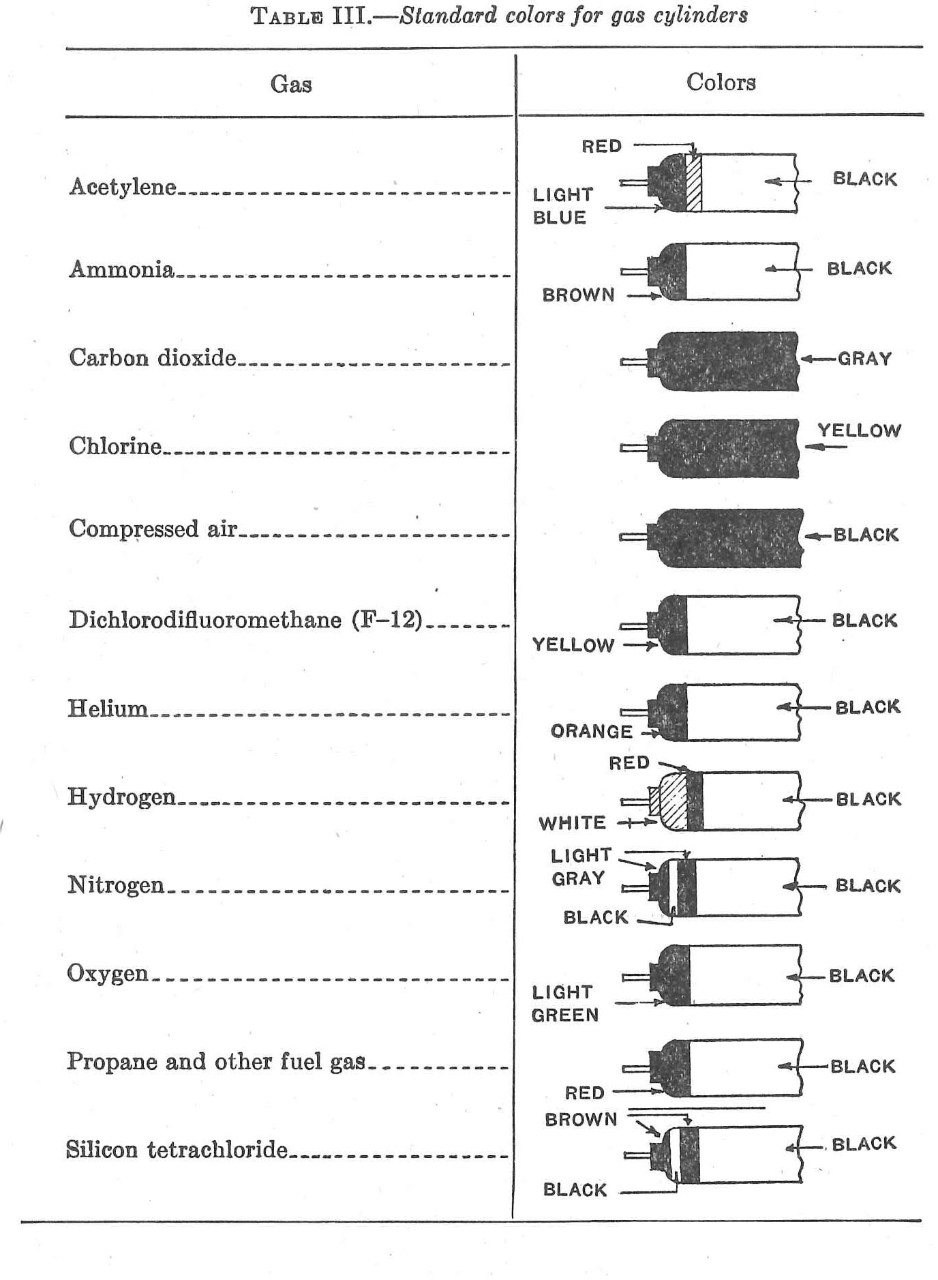
CHAPTER 7.-WOODEN CRAFT
SECTION 7-A.
WOODEN AND COMPOSITE VESSELS OF HEAVY CONSTRUCTION AND SPECIAL DESIGN.
Preparation of surface.-Wood surfaces shall be treated with a toxic water-repellent type of wood preservative, Navy Department Specification 52W5, to control decay and checking.
Application to hull structure.-The toxic water-repellent solution shall be applied as follows:
After all boring, cutting, surfacing, and assembly, after the maximum practicable drying period and before appreciable surface seasoning checks appear, and before any painting is done, and before any planking or ceiling is applied, all hull structural members, including frames, floors, keels, keelsons, stringers, chines, clamps, sheaves, breast-hooks, stems, stem-knees, aprons, quarter-knees, etc., shall be treated with the solution. Only grade II material shall be applied on structural members below the water line. The solution shall be applied by swabbing with a suitable mop or large capacity brush, or by spraying. All surfaces shall be thoroughly covered with solution and the ends and joints especially shall be copiously drenched with it.
Application to planking, ceiling, plywood, and decking.-The toxic water-repellent solution shall be applied as follows after the maximum practicable drying period but before appreciable seasoning checks appear and before any painting is done:
(1) After each bolt or screw hole is bored, it shall be treated by spraying or injecting sufficient solution to thoroughly drench the inside surface of the hole.
(2) After fastening, but before plugging the countersunk bolts and screws, and after any calking, the interior and exterior surfaces of the planking, and especially the jointed ends and ends adjoining transom and stem, shall be thoroughly swabbed or sprayed with the preservative.
(3) Where more than 1 thickness of planking or decking is applied, each shall be treated, including the fabric lining separating them.
(4) All butt blocks shall be thoroughly treated by soaking for at least 30 minutes in the preservative solution, and all plugs should be soaked at least 5 minutes.
(5) All ceiling, plywood, and decking shall be treated, using in general the same procedure described above for applying the solution, employing the simplest method to thoroughly drench all surfaces, particularly jointed ends. Immersion for 3 minutes in the preservative is preferred; otherwise brushing or spraying is acceptable.
39
The surface of the hull and framing shall be made acceptably smooth by planning or sanding.
Exposed surfaces of living and working spaces shall be sanded down to a smooth, even texture.
Dents and holes shall be filled with putty. Seams in hull planking shall be calked with oakum or cotton, unless small, when lampwicking shall be used. The seams and calking material shall be treated to refusal by spraying with the toxic wood preservative. Putty, formula 69, colored to match final paint, shall be used for filling. The putty shall be worked well down to the calking material and the seams filled nearly flush with the surface of the planking to allow for swelling after the vessel is waterborne. Deck seams shall be calked with cotton and oakum and payed with marine glue, Navy Department Specification 52G6.
Priming.-Wood to be varnished (finished “bright”) shall be filled with a stain which gives the required color.
Wood not to be painted shall be primed with one coat of varnish, formula 80.
Wood to be painted shall be primed with a coat of the finish paint thinned with one pint of boiled linseed oil (Federal Specification JJJ-O-331) to a gallon of paint.
Faying surfaces shall be carefully painted during assembly. End grain shall be especially well painted. Antifouling paint No. 16 shall be used for faying surfaces of planking. On other parts, outside paint to match finish color shall be used on faying surfaces.
Underwater body.-The boot-topping area or waterline shall be struck in as indicated on the outboard profile plan. Two coats of black paint, Navy Department Specification 52P29 shall be applied.
The underwater body below the boot-topping or waterline shall be painted with three coats of copper bottom paint, formula 16.
In addition, when required by the Detail Specifications, the bottoms of survey vessels or vessels to operate in teredo-infested waters shall also be sheathed all over up to the waterline. Hot rolled, or cold rolled and annealed soft copper sheet, 0.02 inch thick, secured by copper tacks, shall be used. The butts in the sheathing shall be lapped aft and hammered down to form a smooth, tight seam, which will exclude the small teredos. Before sheathing is fitted, the calking and the bottom paint shall be examined to see that it is in first-class condition.
Exterior above the boot-topping-Exercise shall be painted with two coats of the appropriate shade of formula 5 for vertical surfaces and formula 20 for decks as directed for vessels of metal construction.
Interior.-Top and sides of the interiors of the following spaces shall be finished white by applying two coats of inside white, formula 27:
(1) Staterooms.
(2) Lockers and stowage spaces except as otherwise specified.
The following interior work shall be given two coats of varnish, formula 80, in addition to the prime coat of varnish; the final coat will be rubbed to a dull finish:
(1) In crew’s quarters: Transom fronts, baseboard, dresser, plate rack and mess table.
(2) In staterooms: Drawers in berths, baseboard, wireless table, desk, bookshelves, and lockers.
(3) In galley: Dressers, dish rack, baseboard and food locker.
(4) Ladders: All wooden ladders.
All wood flooring, including slat flooring, shall be given two coats of light gray paint, formula 20-L, or tinted to the satisfaction of the Supervisor of Shipbuilding.
The whole of the interior of the hull, where not otherwise specified, and where not exposed in the cabin, shall be given two coats of inside white, formula 27 (see specifications above).
Steel work and the exterior of tanks shall be given two coats of zinc-chromate primer, formula 84, followed by one coat of inside white, formula 27.
Inside of the pilothouse shall be given two coats of light gray paint, formula 27-L.
The engine room shall be painted with one coat of light gray up to trunk, and the trunk painted white, number of coats to be the same as other interior work.
Magazines shall be painted white, formula 27.
Interior spaces not specifically called for otherwise shall be painted inside white, formula 27.
Identification.-Large wooden vessels shall be identified as indicated under metal construction.
SECTION 7-B.
STANDARD BOATS.
Preparation of surface.-Wood surfaces shall be treated with wood preservative to control decay and checking (see section 7-A of chap. 7).
The surface of the hull and framing shall be made acceptably smooth by planning or sanding.
Exposed surfaces to living and working spaces shall be sanded down to a smooth, even texture.
41
Priming.-Wood to be varnished (finished “bright”) shall be filled with a stain which gives the required color.
Wood to be painted shall be primed with one coat of varnish, formula 80.
Faying surfaces shall be carefully painted during assembly. End grain shall be especially well painted. Antifouling paint, formula 16, shall be used for planking. On other parts, outside paint to match the finish color shall be used for this purpose.
Underwater body.-Standard boats shall have the underwater body painted with two coats of copper bottom paint tinted black by adding ½ pound of lampblack to each gallon of copper bottom paint, formula 16. Flag officers’ motorboats shall have the underwater body painted with bronze bottom paint in accordance with Navy Department Specification 52P20. This bottom paint shall extend from the keel to 4 inches above the waterline for pulling boats; to 6 inches above the waterline for power boats up to 30 feet long; and to 8 inches above the waterline for power boats over 30 feet long.
Copper sheathing: In addition, the bottom of a powerboat issued to a survey vessel or a shore station in teredo-infested waters shall be sheathed all over, up to the waterline. Hot-rolled, or cold-rolled and annealed soft copper sheet, 0.02 inch thick, secured by copper tacks, shall be used. The butts in the sheathing shall be lapped aft and hammered down to form a smooth, tight seam, which will exclude the small teredos. Before sheathing is fitted, the calking and the bottom paint shall be examined to see that it is in first-class condition.
Exteriors.-Exteriors of standard boats above the waterline shall be painted during manufacture with one coat of haze gray, formula 5-H. Inside surfaces exposed to the weather shall be painted similarly. Calked decks shall not be painted. Floorboards and walking surfaces exposed to the weather shall be painted with deck blue, formula 20-B. The hulls of flag officers’ motorboats shall be painted above the waterline with a high gloss black enamel, formula 24. The canopies of these boats shall be painted with high gloss white enamel, formula 30. A second coat of exterior paint as required herein shall be applied by the building yard at the time the vessel to which this boat is assigned received its final painting. The colors of this second coat shall conform to the painting system described for the larger vessel in the area in which the coat is stowed. When required by the
42
Supervisor of Shipbuilding, the deck blue shall be applied in two coats to the exposed calked decks of the boat in order to conform to the camouflage scheme for the major vessel.
Interiors.-Interiors shall be painted with two coats of inside white, formula 27, and one coat of white enamel, formula 30. Footings, floors, and bilges shall be painted with light gray deck paint, formula 20-L. Trim shall be finished with three coats of varnish, formula 80.
Identification symbols.-Identification symbols or other insignia of the major vessel to which the boat is to be attached shall be provided by the yard building the major vessel in accordance with plan Bu. Ships No. 220598. They shall be installed only if directed by the Supervisor of Shipbuilding.
SECTION 7-C.
LIGHTLY BUILT HIGH SPEED CRAFT OF NONMETALLIC CONSTRUCTION.
Preparation of surface.-Wood surfaces shall be treated with an approved wood preservative to control decay and checking (see section 7-A of chap.7).
The surface of the hull and framing shall be made acceptably smooth by planning and sanding.
Exposed surfaces of living and working spaces shall be sanded down to a smooth, even texture.
Dents and holes shall be filled with putty. Seams in hull planking shall be calked with cotton, unless small, when lampwicking shall be used. The seams and calking material shall be treated to refusal by spraying with the toxic wood preservative. Putty, formula 69, colored to match final paint, shall be used for filling. The putty shall be worked well down to the calking material shall be treated to refusal by spraying with the toxic wood preservative. Putty, formula 69, colored to match final paint, shall be used for filling. The putty shall be worked well down to the calking material and the seams filled nearly flush with the surface of the planking. Deck seams shall be calked with cotton and payed with marine glue.
Priming.-Wood to be varnished (finished “bright”) shall be filled with a stain which gives the required color.
Wood to be painted shall be primed with the finish paint thinned with one pint of boiled linseed oil (Federal Specification JJJ-O-331) to a gallon of paint.
Wood not to be painted shall be primed with one coat of varnish, formula 80.
Faying surfaces shall be carefully painted during assembly. End grain shall be especially well painted. Antifouling paint, formula 16, shall be used for planking. On other parts, outside paint to match finish color shall be used for this purpose.
43
Underwater body.-The boot-topping or waterline shall be struck in as indicated on the outboard profile plan.
The underwater body below the boot-topping or waterline shall be painted with two coats of copper bronze bottom paint in accordance with Navy Department Specification 52P20.
Exteriors.-Vertical and horizontal surfaces shall be painted in accordance with existing camouflage instructions.
Interiors.-Interiors shall be painted with two coats of inside white, formula 27, and one coat of white enamel, formula 30. Footlings, floors, and bilges shall be painted with light gray deck paint, formula 20-L. Trim shall be finished bright with two coats of varnish, formula 80.
Identification.-Identification shall be as directed by the vessels’ plans and detail specifications.
CHAPTER 8.-FORMULAS AND SPECIFICATIONS
SECTION 8-A.
FORMULAS AND SPECIFICATIONS.
Previous editions of this publication have shown in detail the manufacturing formulas of all paints and varnishes, as a basis for the control of quality. Specifications are now in preparation for all of the paints and varnishes specified herein by formula designation. Pending issue of specifications printed sheets for each formula are available in most instances for distribution, giving manufacturing details. However, specifications and formulas for anticorrosive, antifouling, boot-topping, submarine ballast and submarine superstructure coatings are not furnished to contractors because the necessary close control of quality of products is impracticable. These products will be supplied as government furnished items. Specifications where applicable or in lieu thereof standard manufacturing formulas which have been approved by the Bureau shall govern the procurement of materials from commercial sources and the manufacture of products by the navy yards.
Containers shall be labeled with the name of the paint and the formula designation.
The following are the formula designations and specification symbols where applicable to date, with a brief statement of the purpose for which the product is used primarily and also including its indicated suitability for other purposes.
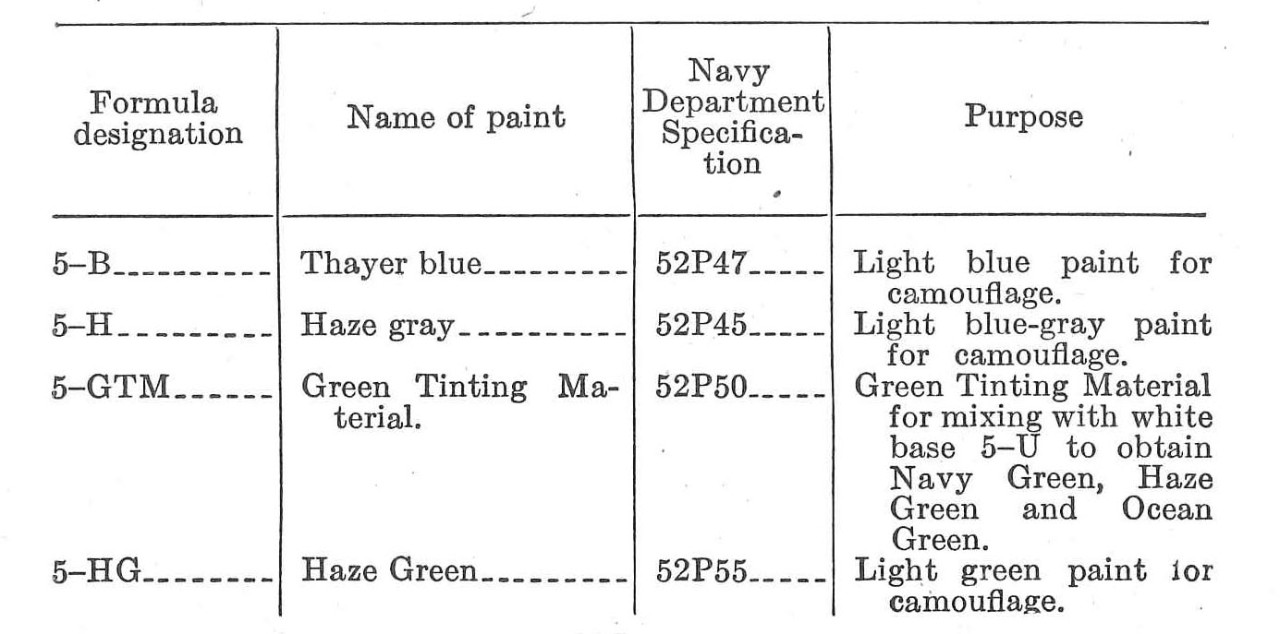
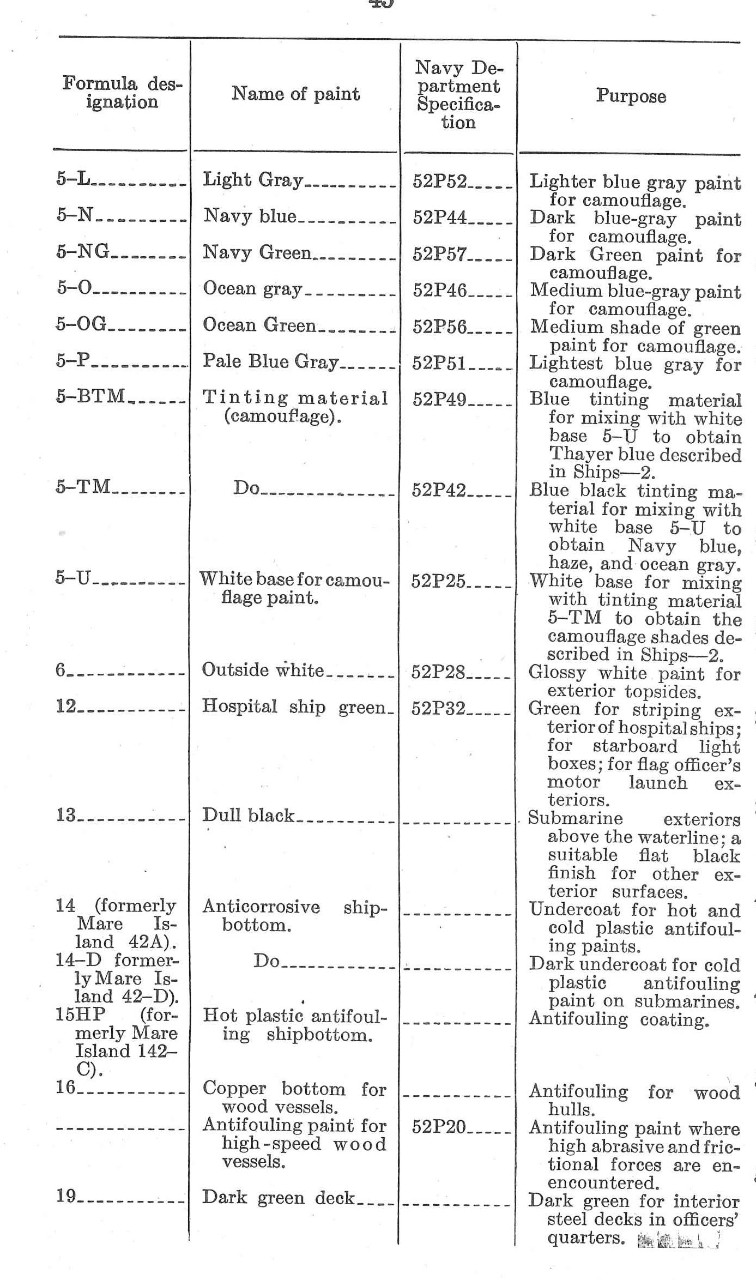
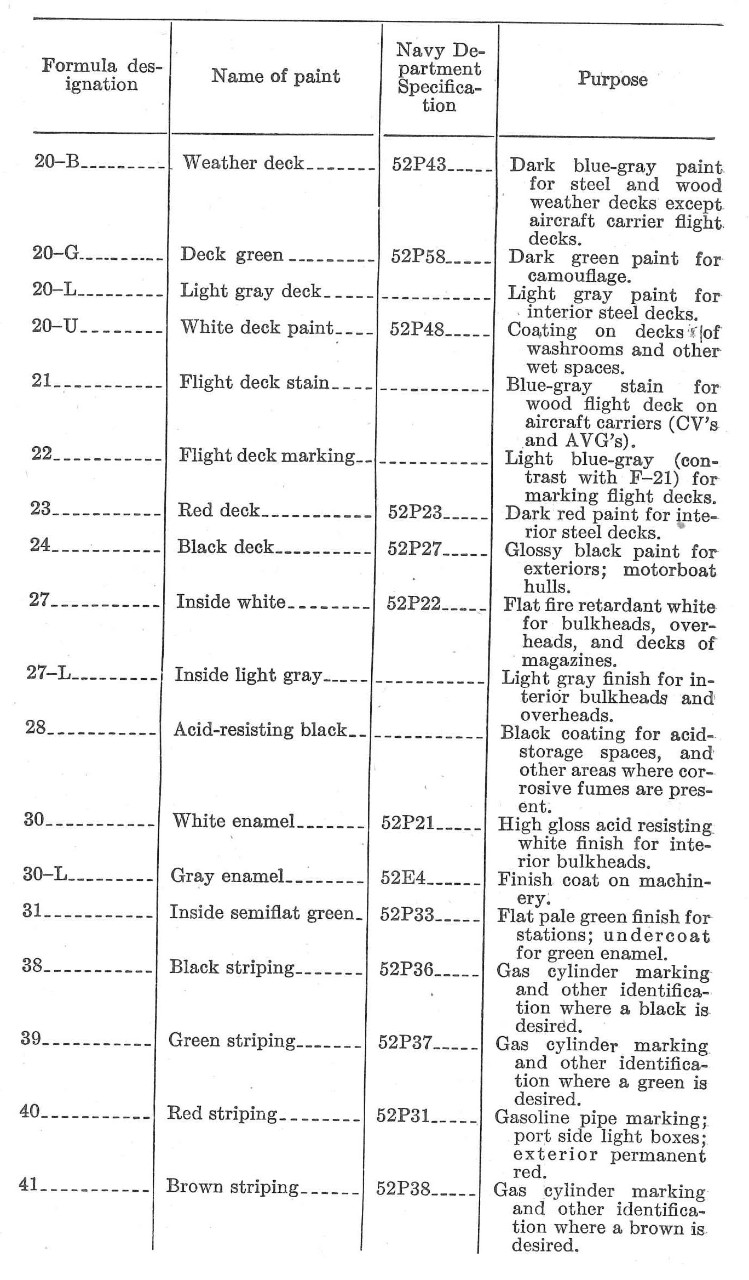
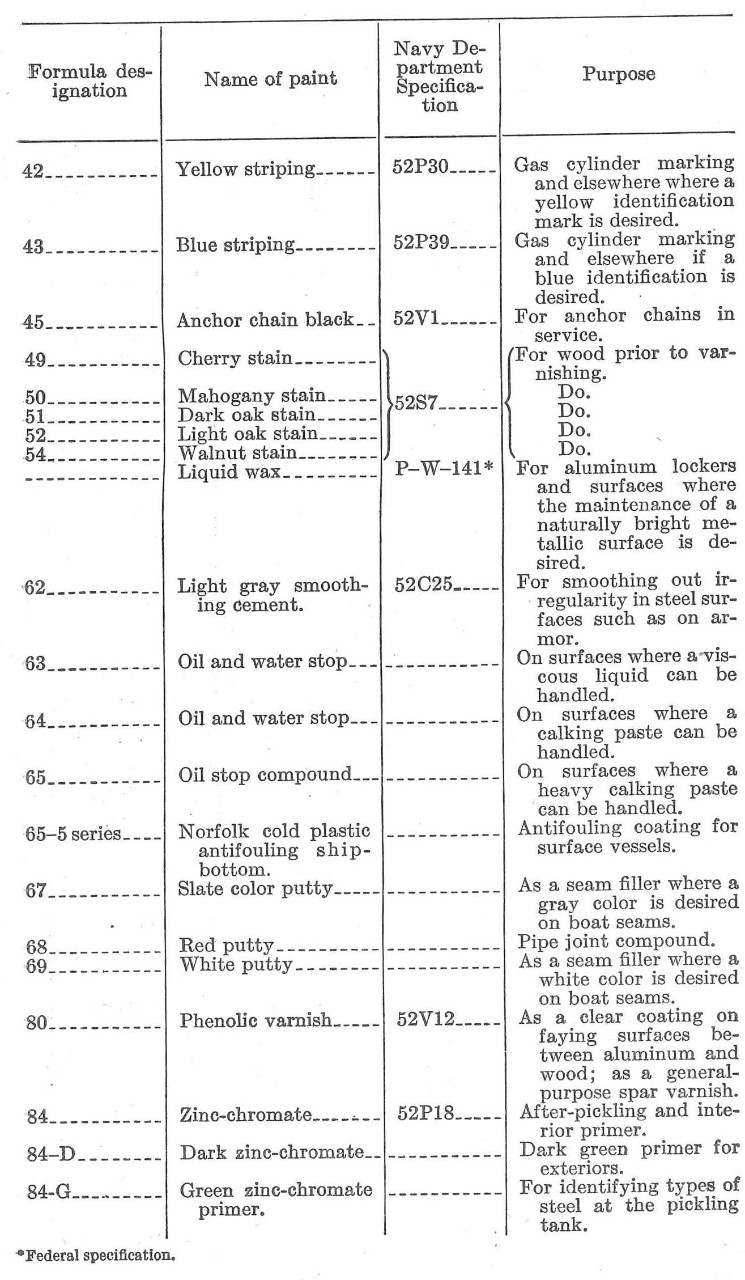
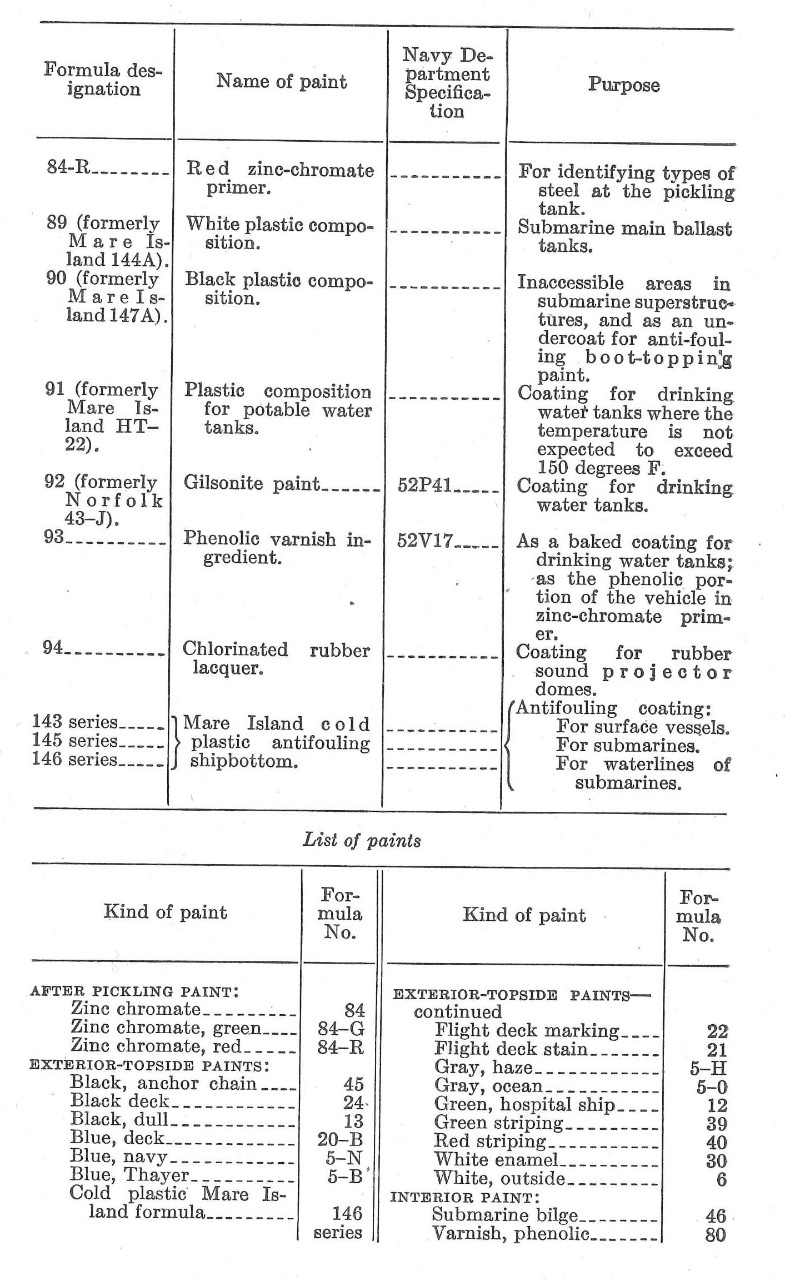
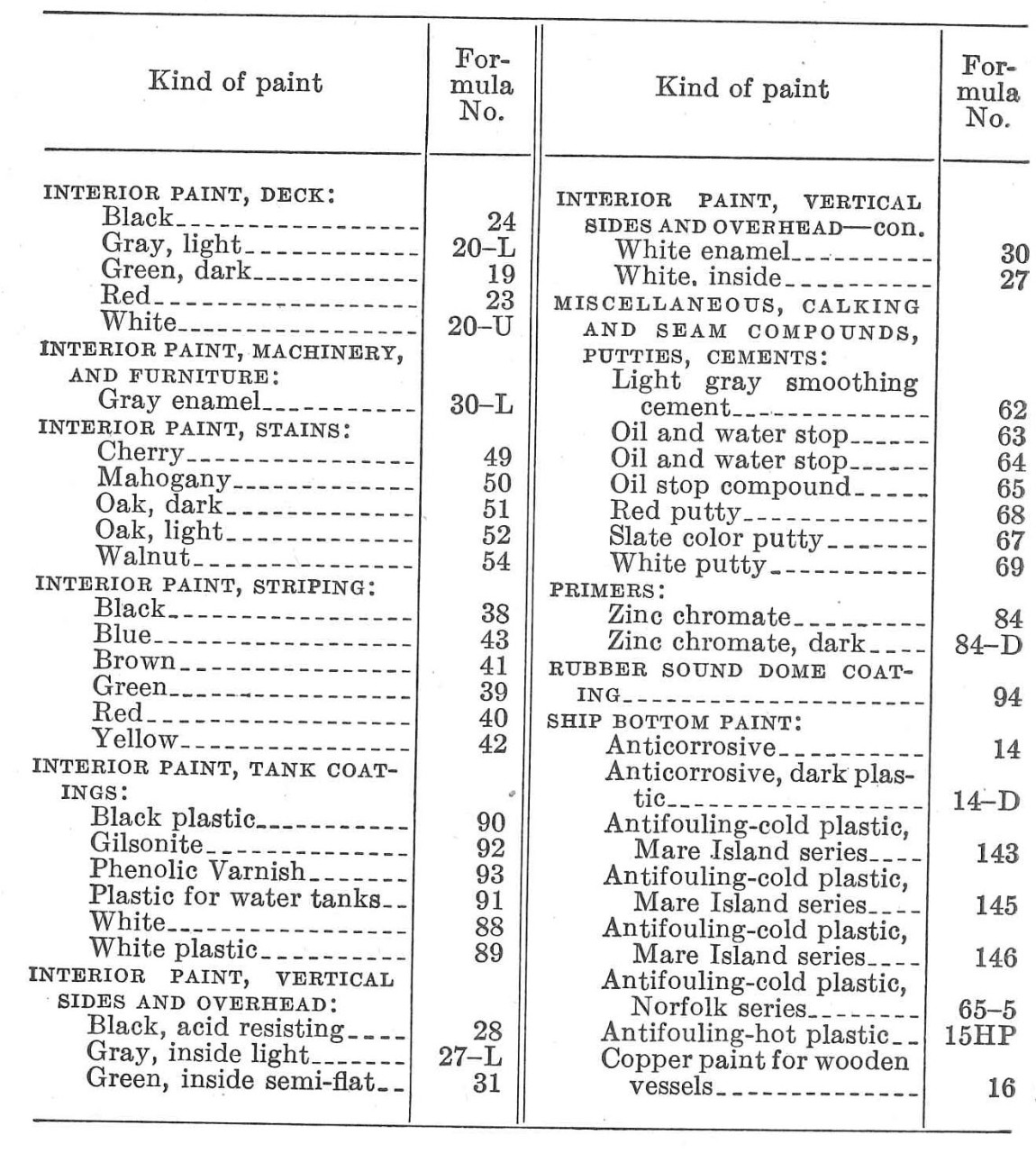
Film thickness-spreading rate.-Emphasis has been placed in chapter 1 upon a maximum film thickness of paint on interior surfaces to minimize the fire hazard and to save weight. Film thickness involves spreading rate and volume of nonvolatile components of a paint. Also it is often desirable to know the spreading rate of a paint in estimating costs. For ready reference a graph is shown indicating the relationship between spreading rate, film thickness, and volume of nonvolatile components. If the value of any two of these properties is known the third can be determined from the chart. For example, if the spreading rate is known to be about 400 square feet per gallon and the nonvolatile component volume is 40 percent, the average thickness of the dry film should be about .0016 inch. If the inspector measures the film thickness and finds it averages about .0024 inch he will know that the spreading rate was about 275 square feet per gallon or that more than one coat was applied.
The volume of the nonvolatile components of a paint can be computed from the manufacturing formula. As an example, the steps in determining the value for the nonvolatile components in the zinc-chromate primer, formula 84, are given:
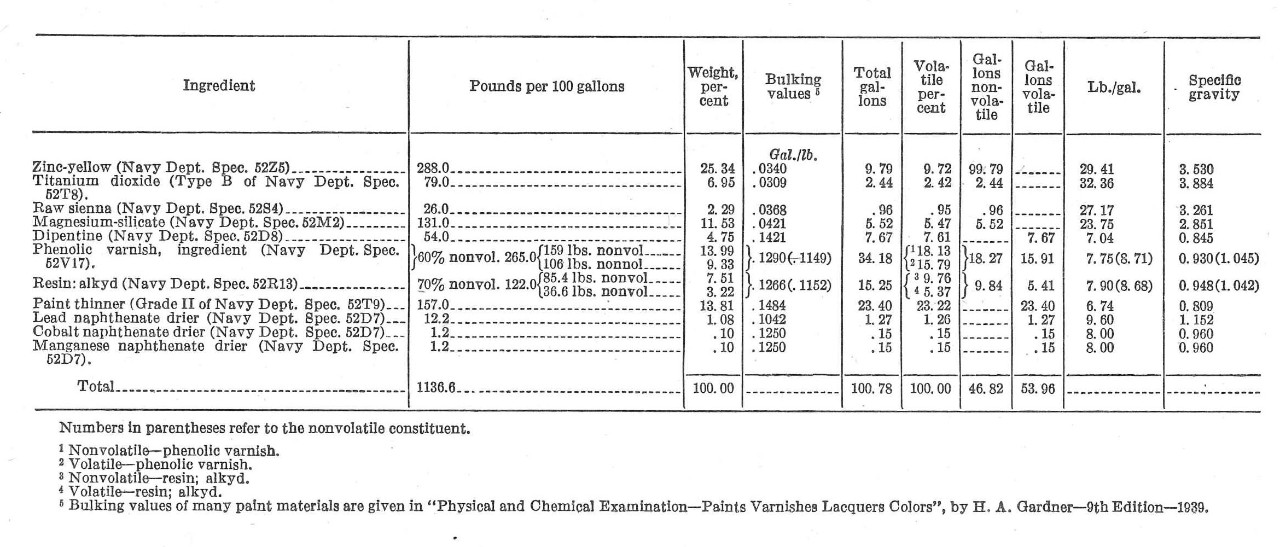
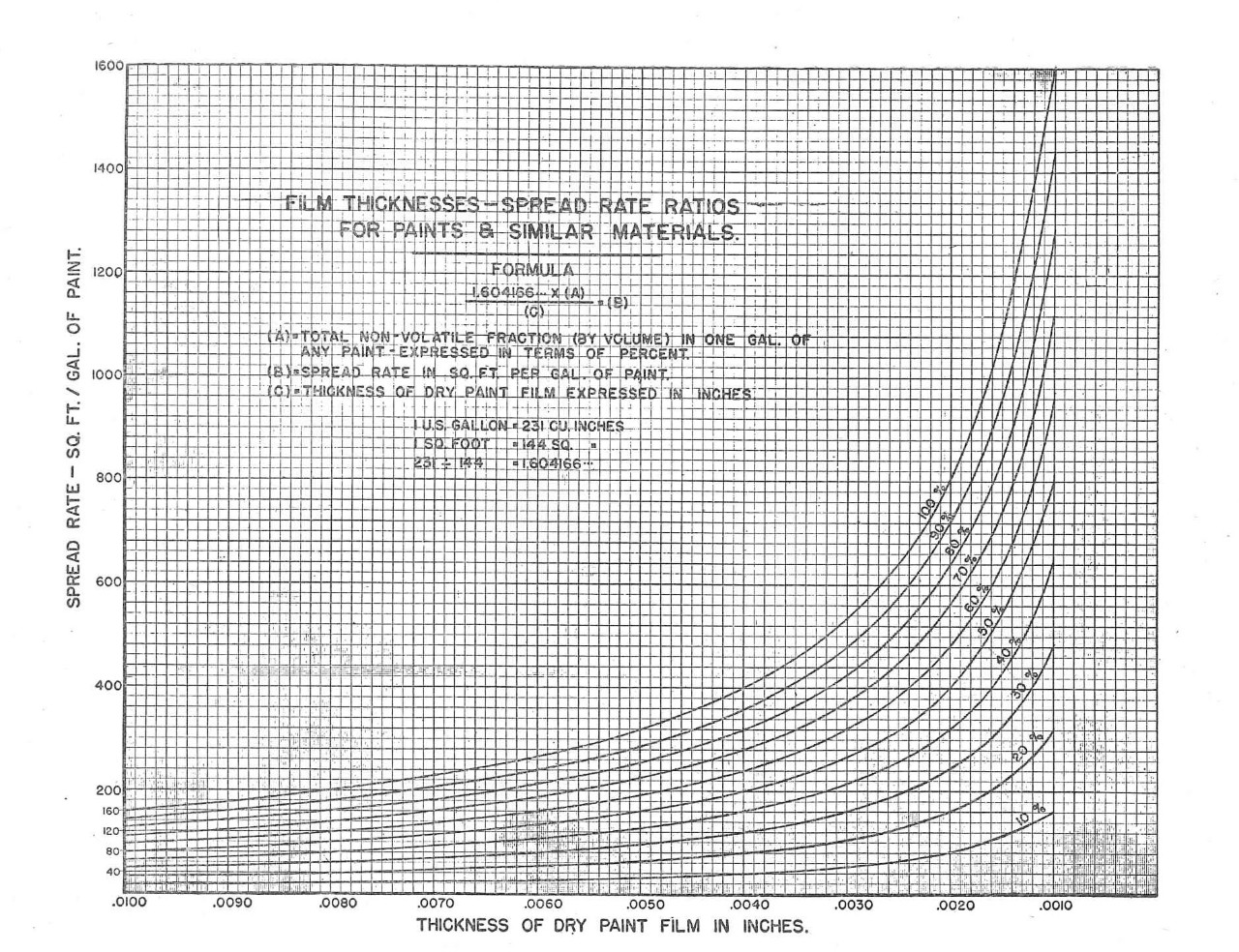
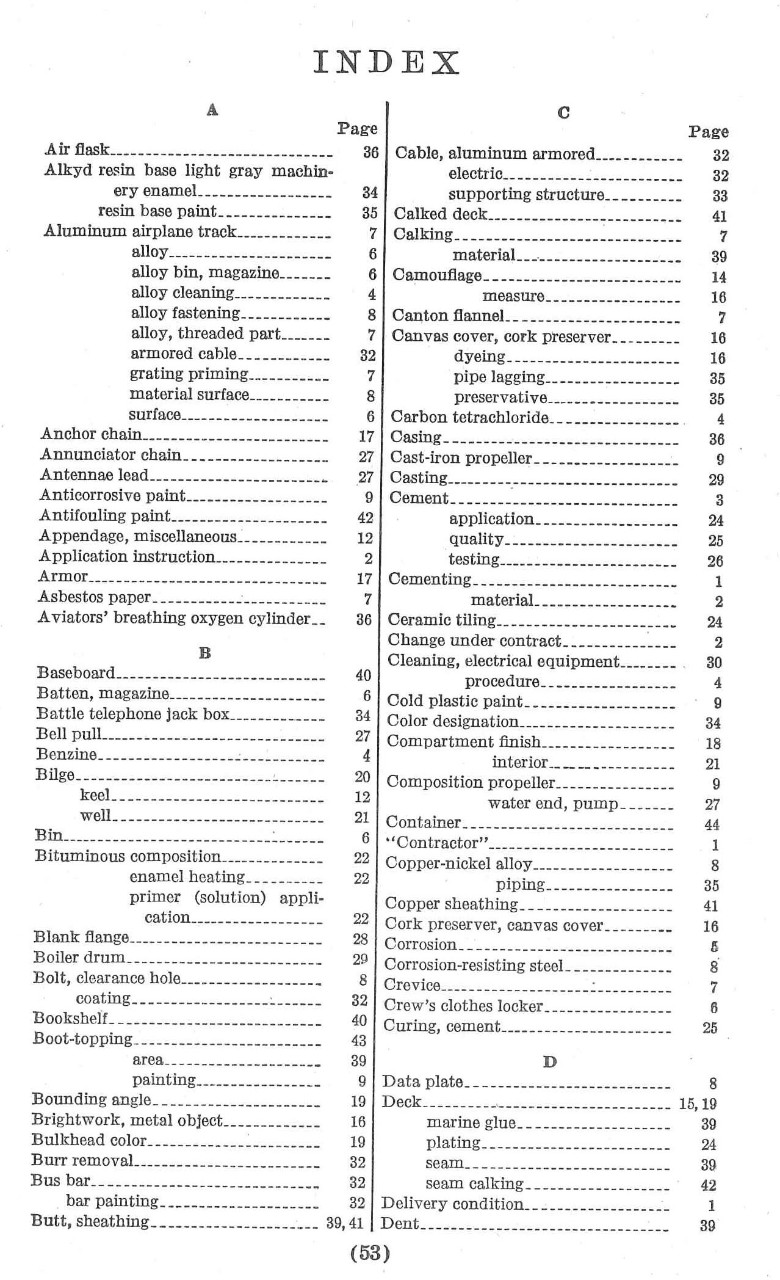
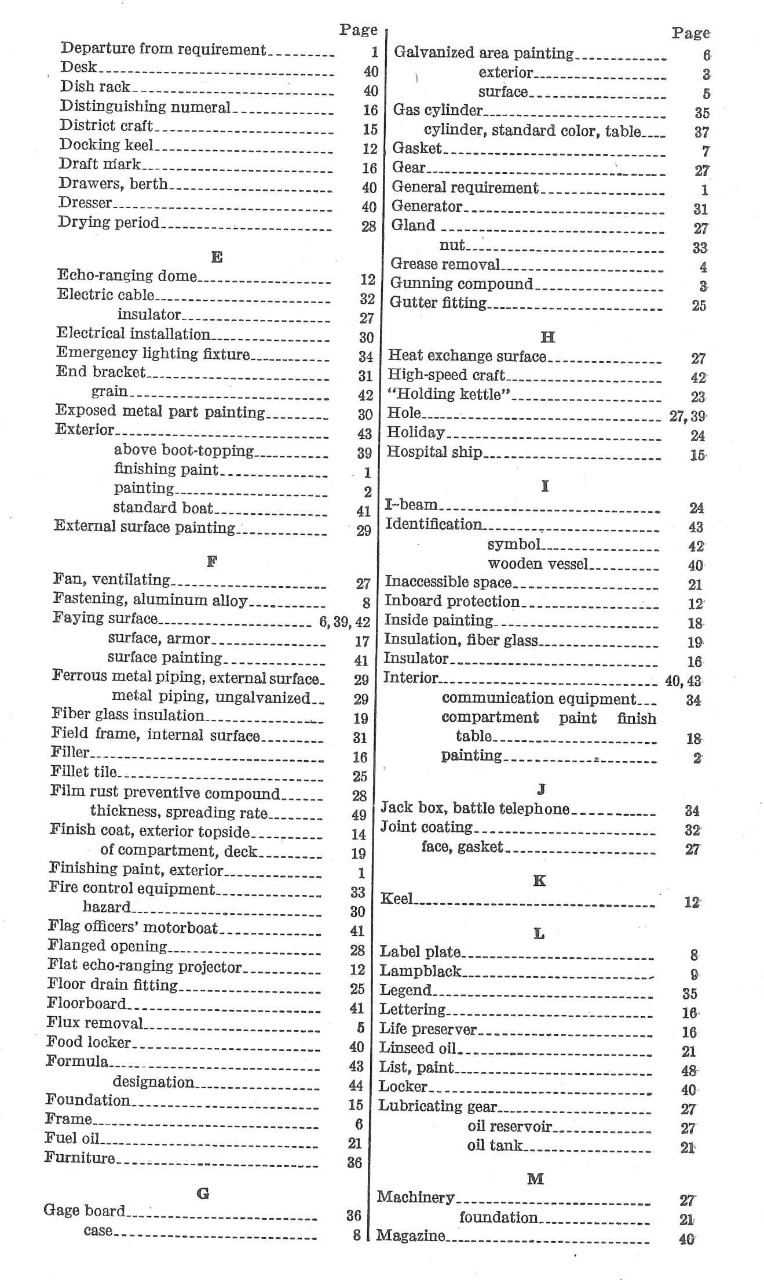
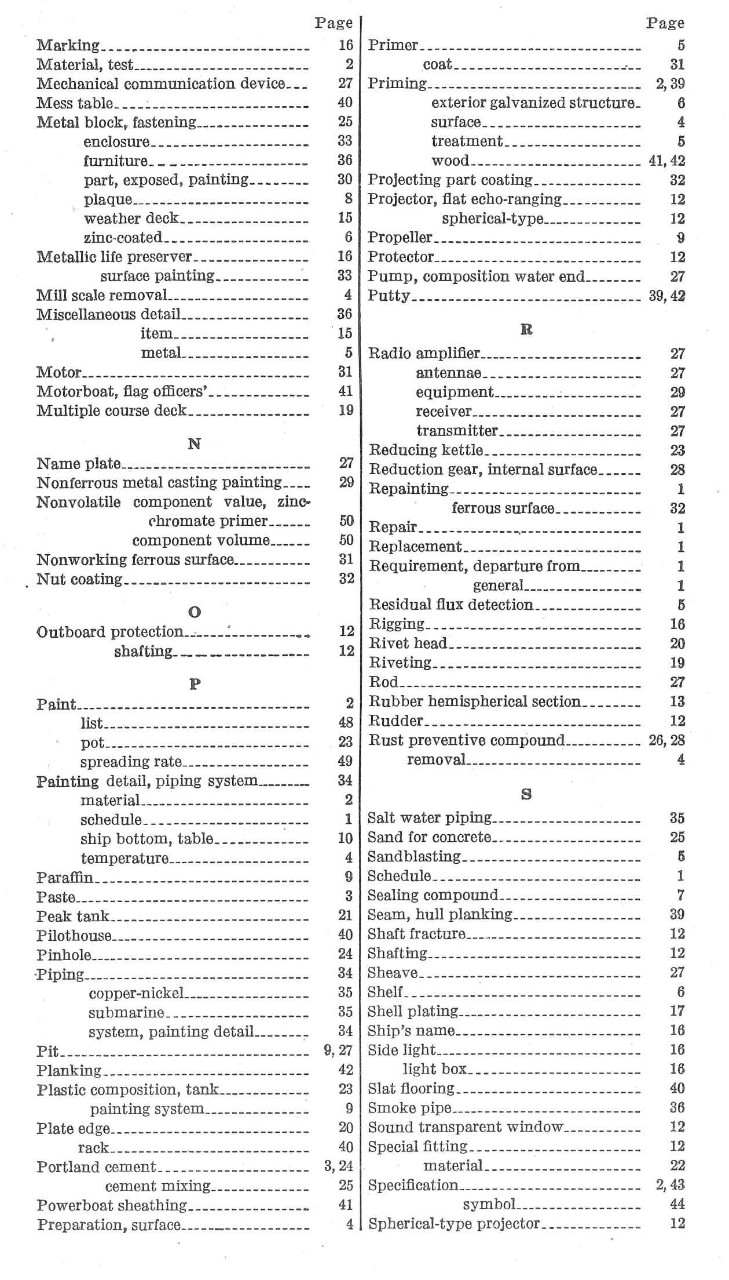
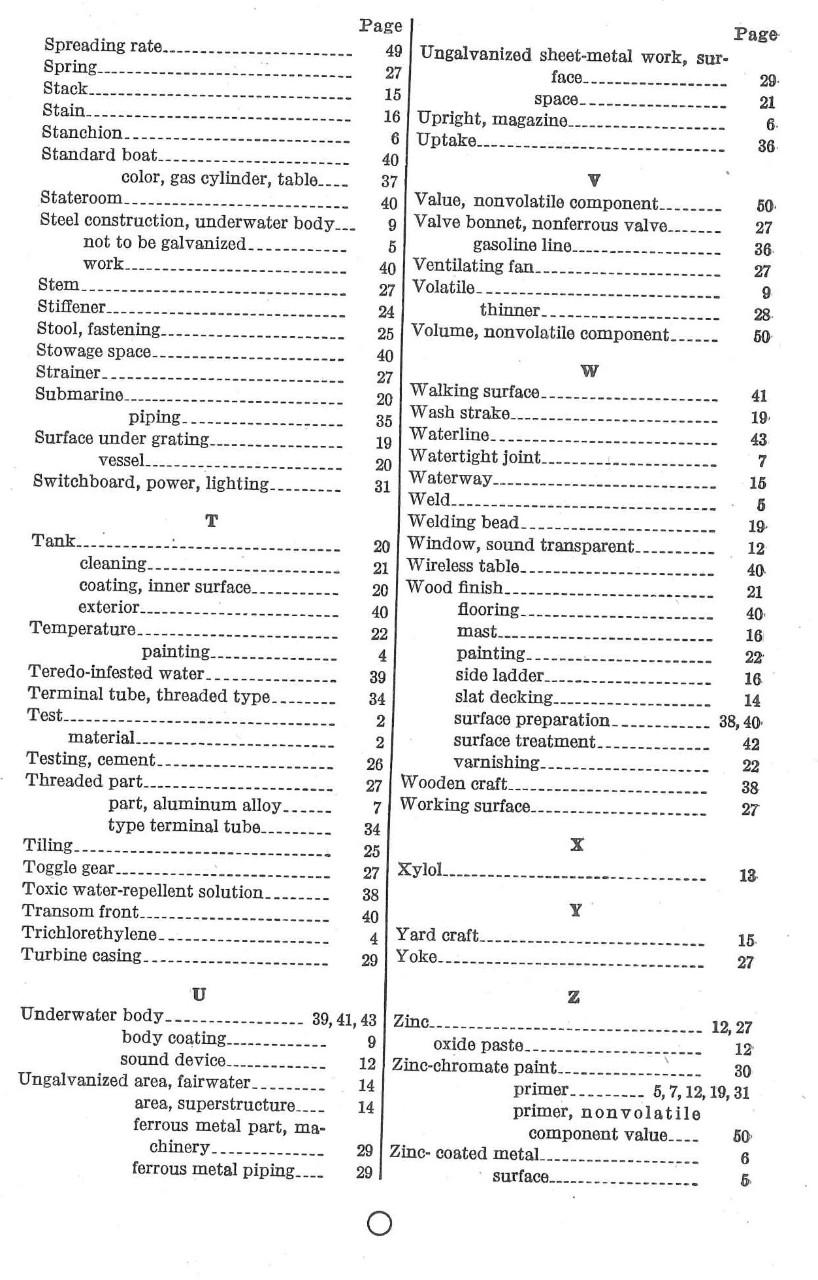
END



